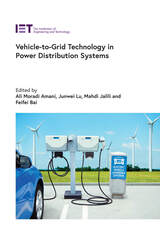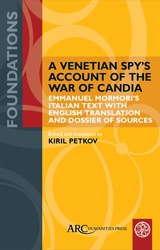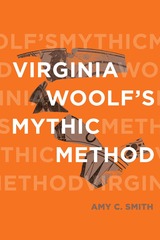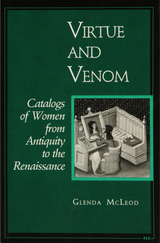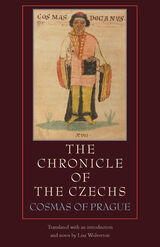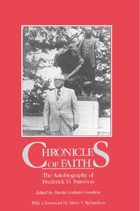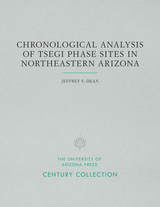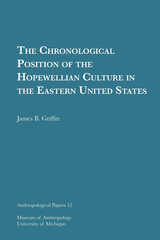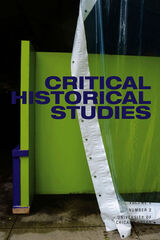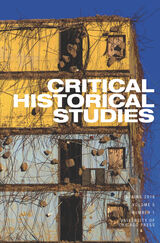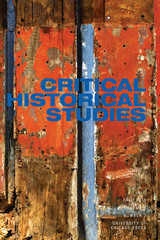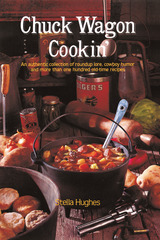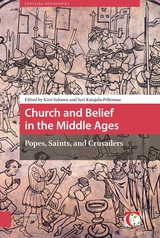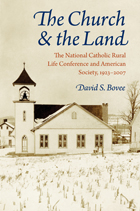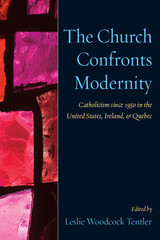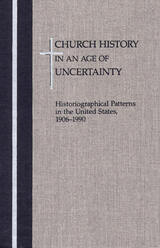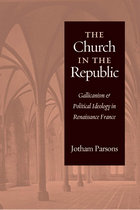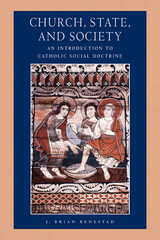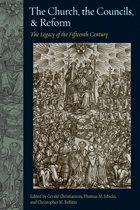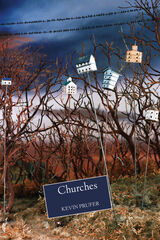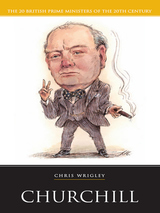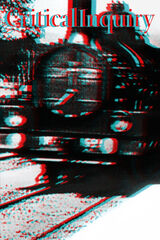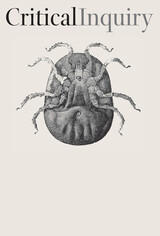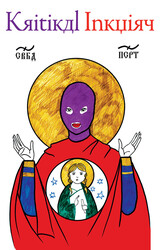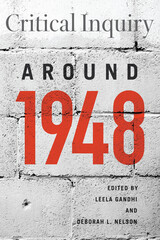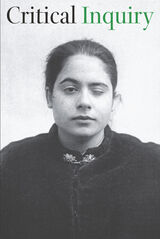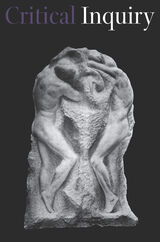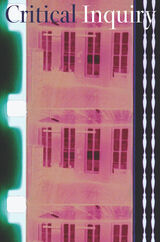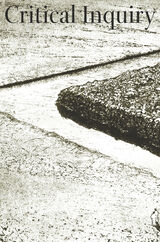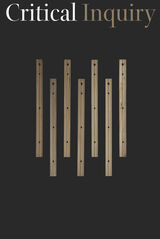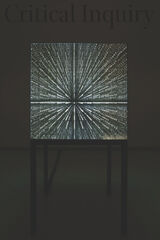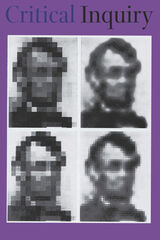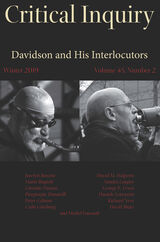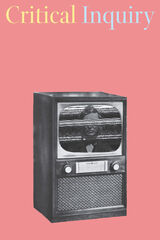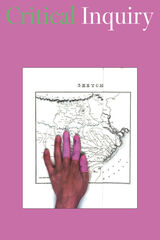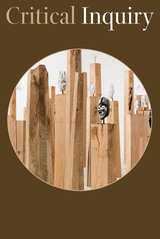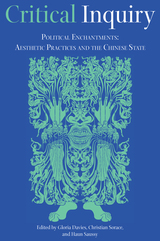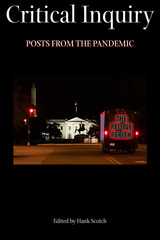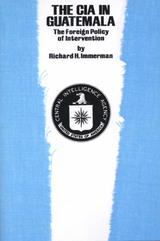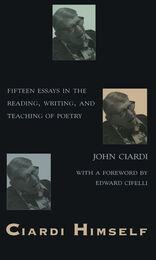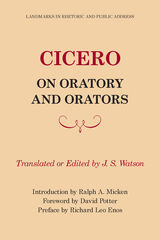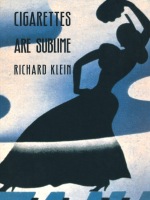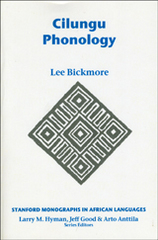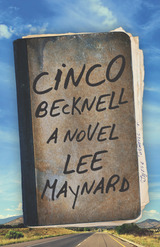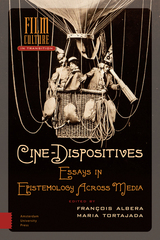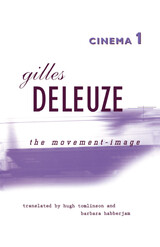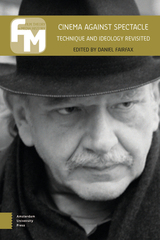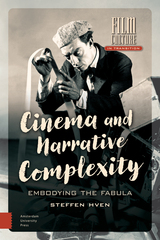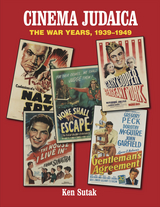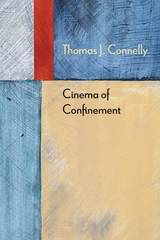The Chronicle of the Czechs
Cosmas of Prague
Catholic University of America Press, 2009 The Chronicle of the Czechs by Cosmas of Prague (d. 1125) is a masterwork of medieval historical writing, deeply erudite, consciously researched, and narrated in high rhetorical style.
 A Chronicle of the Last Pagans
Pierre Chuvin
Harvard University Press, 1990 A Chronicle of the Last Pagans is a history of the triumph of Christianity in the Roman Empire as told from the perspective of the defeated: the adherents of the mysteries, cults, and philosophies that dominated Greco–Roman culture.
With a sovereign command of the diverse evidence, Pierre Chuvin portrays the complex spiritual, intellectual, and political lives of professing pagans after Christianity became the state religion. While recreating the unfolding drama of their fate—their gradual loss of power, exclusion from political, military, and civic positions, their assimilation, and finally their persecution—he records a remarkable persistence of pagan religiosity and illustrates the fruitful interaction between Christianity and paganism. The author points to the implications of this late paganism for subsequent developments in the Byzantine Empire and the West. Chuvin's compelling account of an often forgotten world of pagan culture rescues an important aspect of our spiritual heritage and provides new understanding of Late Antiquity.
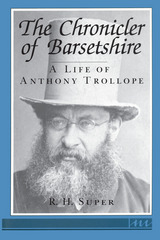 The Chronicler of Barsetshire: A Life of Anthony Trollope
R. H. Super
University of Michigan Press, 1990 The Chronicle of Barsetshire presents the life of Anthony Trollope, who, although perhaps best known for his popular novels of Victorian English life, was also a prolific writer of nonfiction and a distinguished civil servant. R. H. Super, professor emeritus of English at the University of Michigan, has drawn upon a wide range of primary sources, archival as well as published, to give a complete sense of the man, his variety of talents, his place in the intellectual world of nineteenth-century England, and the interplay between his fiction and the events of his life. It is a biography of the highest merit, a work that, unlike the previous studies of Trollope's life, is not overshadowed by Trollope's own colorful (but frequently inaccurate) Autobiography. Exhaustive in its portrayal of Trollope's long, productive life, and impeccable in its scholarship, The Chronicler of Barsetshire sets a new standard of execellence in Trollopian studies.
 Chronicles of a Global City: Speculative Lives and Unsettled Futures in Bengaluru
Vinay Gidwani
University of Minnesota Press, 2024 Tracking Bengaluru’s dramatic urban transformation through the entanglements of finance, land frenzy, real estate volatility, and livelihood upheavals
Over the past two decades, Bengaluru’s exploding real estate sector and massive infrastructure investments have led to land speculation targeting working-class neighborhoods and agricultural land for development. Chronicles of a Global City turns Bengaluru inside out to examine its “world-city” transformation that stimulated rapid urbanization and unbounded growth. Moving the spotlight away from the urban elites and “new middle class,” this book explores how people caught up in the whirlwinds of change in Bengaluru—from construction laborers, street vendors, domestic workers, and platform delivery workers to small-time property brokers, petty landlords, and local politicians—experience, struggle, aspire, invent, strive, and speculate to make a livable city for themselves. Grounded in long-term ethnographic research and activist experiences, Chronicles of a Global City vividly illuminates the multifaceted entanglements of finance capital, real estate markets, livelihood struggles, and fraying ecologies in urban and peri-urban Bengaluru. Its anchoring concept, “speculative urbanism,” provides a powerful, innovative lens for understanding the risk-laden practices of leveraging land, labor, and resources for the promise of future profit. Contributors: Hemangini Gupta, Pierre Hauser, Priyanka Krishna, Eesha Kunduri, Kaveri Medappa, Usha Rao, Shaheen Shasa, Swathi Shivanand, Vinay K. Sreenivasa.
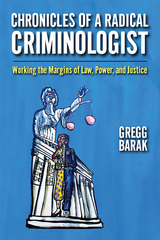 Chronicles of a Radical Criminologist: Working the Margins of Law, Power, and Justice
Gregg Barak
Rutgers University Press, 2020 Over the past five decades, prominent criminologist Gregg Barak has worked as an author, editor, and book review editor; his large body of work has been grounded in traditional academic prose. His new book, Chronicles of a Radical Criminologist, while remaining scholarly in its intent, departs from the typical academic format. The book is a a first-person account that examines the linkages between one scholar's experiences as a criminologist from the late 1960s to the present and the emergence and evolution of radical criminology as a challenge to developments in mainstream criminology. Barak draws upon his own experiences over this half-century as a window into the various debates and issues among radical, critical, and technocratic criminologies. In doing so, he revisits his own seminal works, showing how they reflect those periods of criminological development.
What holds this book together is the story of how resisting the crimes of the powerful while struggling locally for social justice is the essence of critical criminology. His seven chapters are divided into three parts—academic freedom, academic activism, and academic praxis—and these connected stories link the author's own academic career in Berkeley, California; Las Vegas, Nevada; Chicago; Alabama; Ann Arbor, Michigan; and across the United States. Barak's eventful scholarly life involved efforts to overcome laws against abortion and homosexuality; to formalize protective practices for women from domestic violence and sexual assault; to oppose racism and classism in the criminal justice system; to challenge the wars on gangs, drugs, and immigrants; and to confront the policies of mass incarceration and the treatment of juvenile offenders.
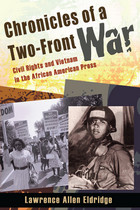 Chronicles of a Two-Front War: Civil Rights and Vietnam in the African American Press
Lawrence Allen Eldridge
University of Missouri Press, 2011 During the Vietnam War, young African Americans fought to protect the freedoms of Southeast Asians and died in disproportionate numbers compared to their white counterparts. Despite their sacrifices, black Americans were unable to secure equal rights at home, and because the importance of the war overshadowed the civil rights movement in the minds of politicians and the public, it seemed that further progress might never come. For many African Americans, the bloodshed, loss, and disappointment of war became just another chapter in the history of the civil rights movement. Lawrence Allen Eldridge explores this two-front war, showing how the African American press grappled with the Vietnam War and its impact on the struggle for civil rights. Written in a clear narrative style, Chronicles of a Two-Front War is the first book to examine coverage of the Vietnam War by black news publications, from the Gulf of Tonkin incident in August 1964 to the final withdrawal of American ground forces in the spring of 1973 and the fall of Saigon in the spring of 1975.
Eldridge reveals how the black press not only reported the war but also weighed its significance in the context of the civil rights movement. The author researched seventeen African American newspapers, including the Chicago Defender, the Baltimore Afro-American, and the New Courier, and two magazines, Jet and Ebony. He augmented the study with a rich array of primary sources—including interviews with black journalists and editors, oral history collections, the personal papers of key figures in the black press, and government documents, including those from the presidential libraries of Lyndon Johnson, Richard Nixon, and Gerald Ford—to trace the ups and downs of U.S. domestic and wartime policy especially as it related to the impact of the war on civil rights.
Eldridge examines not only the role of reporters during the war, but also those of editors, commentators, and cartoonists. Especially enlightening is the research drawn from extensive oral histories by prominent journalist Ethel Payne, the first African American woman to receive the title of war correspondent. She described a widespread practice in black papers of reworking material from major white papers without providing proper credit, as the demand for news swamped the small budgets and limited staffs of African American papers. The author analyzes both the strengths of the black print media and the weaknesses in their coverage.
The black press ultimately viewed the Vietnam War through the lens of African American experience, blaming the war for crippling LBJ’s Great Society and the War on Poverty. Despite its waning hopes for an improved life, the black press soldiered on.
Chronicles Of Faith: The Autobiography of Frederick D. Patterson
Frederick D. Patterson, edited by Martia Graham Goodson
University of Alabama Press, 1991 Records the life of a man who influenced the course of higher education for African Americans and Africans throughout the twentieth century
Patterson, orphaned soon after birth in 1901, became a veterinary scientist at Tuskegee Institute and soon thereafter--at the depths of the Depression--was selected as president of that most important institution. It was at Tuskegee that Patterson formulated the idea and the organization--the United Negro College Fund. In doing so he made a place for himself in U.S. and world history by providing the model of cooperative fund raising that enabled financially starved private black colleges to survive and serve the youth of the segregated North and South.
 The Chronicles of Notre Dame Du Lac
Edward Sorin
University of Notre Dame Press, 1992 When Edward Sorin left France in 1841 to lead the first band of missionaries sent by the Congregation of Holy Cross to the New World, the rule of the young community required him to keep and send back to France an annual account of the significant events in the life and work of the men and women on the American mission. Chronicles of Notre Dame du Lac contains this running account of the history of the University of Notre Dame—from its foundation in 1842 through the end of the Civil War—written by the man honored as its founder and whose vision for this now world-famous Catholic university is still invoked today.
Through crippling snow storms, devastating fires, and epidemics of cholera and typhoid, the men and women of Holy Cross persisted in their mission to build a college on "this property [that] was then known as St. Mary of the Lakes . . . half a league from South Bend; one league from the northern boundary of Indiana; about twelve leagues from Lake Michigan." With warmth and humor Sorin discusses their humble beginnings, "A single room was placed at the service of the priests, and the Sisters had to themselves the ground floor below the chapel, where they spent nearly two years. Except for the fact that there was only one window, and in consequence of the close atmosphere there was a large stock of lice and bed bugs, they were, as they say in America, pretty comfortable." Sorin's judgments of people and events are recorded with a blunt frankness, including his conflicts with various bishops and his own superior general back in France. If his biases are revealed in these chronicles, so, too, is his commitment to the projects that shaped his life and work.
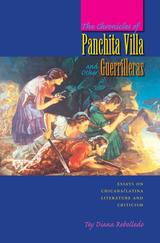 The Chronicles of Panchita Villa and Other Guerrilleras: Essays on Chicana/Latina Literature and Criticism
By Tey Diana Rebolledo
University of Texas Press, 2006 Although there have been substantial contributions to Chicana literature and criticism over the past few decades, Chicanas are still underrepresented and underappreciated in the mainstream literary world and virtually nonexistent in the canon. Writers like Sandra Cisneros, Ana Castillo, and Gloria Anzaldúa have managed to find larger audiences and critical respect, but there are legions of Chicana writers and artists who have been marginalized and ignored despite their talent. Even in Chicano anthologies, the focus has tended to be more on male writers. Chicanas have often found themselves without a real home in the academic world. Tey Diana Rebolledo has been writing about Chicana/Latina identity, literature, discrimination, and feminism for more than two decades. In this collection of essays, she brings together both old and new works to give a state-of-the-moment look at the still largely unanswered questions raised by vigilant women of color throughout the last half of the twentieth century. An intimate introductory essay about Rebolledo's personal experiences as the daughter of a Mexican mother and a Peruvian father serves to lay the groundwork for the rest of the volume. The essays delve into the historical development of Chicana writing and its early narratives, the representation of Chicanas as seen on book covers, Chicana feminism, being a Chicana critic in the academy, Chicana art history, and Chicana creativity. Rebolledo encourages "guerrillera" warfare against academia in order to open up the literary canon to Chicana/Latina writers who deserve validation.
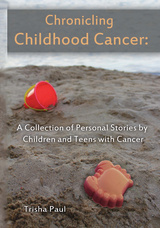 Chronicling Childhood Cancer: A Collection of Personal Stories by Children and Teens with Cancer
Trisha Karena Paul
Michigan Publishing, 2014 In this narrative collection, ten children and teens use their own words and colorful drawings to share their personal experiences with cancer. This diverse collection of patient stories provides insight into the unique lives of these individuals; some are recently diagnosed and undergoing treatment for cancer while others are in remission or have relapsed. These children and teens are honest and perceptive, their stories told with heartfelt emotion.
This book is a resource for all those interested in learning more about childhood cancer, including health practitioners, family, and friends. These stories also have the potential to help other youth diagnosed with cancer.
All of the proceeds received by the University of Michigan Division of Pediatric Hematology/Oncology for this book will be donated: 50% to the Block Out Cancer campaign for pediatric cancer research at the University of Michigan and 50% to the Child and Family Life Program at the University of Michigan C.S. Mott Children’s Hospital.
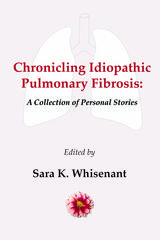 Chronicling Idiopathic Pulmonary Fibrosis: A Collection of Personal Stories
Sara Whisenant
Michigan Publishing, 2016 Receiving a diagnosis of Idiopathic Pulmonary (IPF) can be an intimidating experience. And it can be difficult for new patients to ask hard, personal questions in clinic. But these powerful stories, written byIPF patients and fornewly-diagnosed IPF patients, are where those hard questions are answered. That makes this book a must-read for newly diagnosed patients, their families and loved ones.
In “Chronicling Idiopathic Pulmonary Fibrosis: A Collection of Personal Stories,” you’ll hear the voices of real patients and family members as they talk about what worries them, the coping techniques they have tried and the bright spots of beauty they have found in the course of their journey with this disease. Readers will learn what IPF is and what it is not. They will find new resources and even some questions to help guide their own thoughts when reflecting on what an IPF diagnosis means to them.
The author is grateful to the FRIENDS of the University of Michigan Hospitals Patient Education Library for their generous support of this book. Proceeds from this book will be used to improve the patient experience at the University of Michigan Health System.
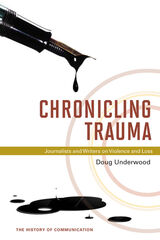 Chronicling Trauma: Journalists and Writers on Violence and Loss
Doug Underwood
University of Illinois Press, 2011 To attract readers, journalists have long trafficked in the causes of trauma--crime, violence, warfare--as well as psychological profiling of deviance and aberrational personalities. Novelists, in turn, have explored these same subjects in developing their characters and by borrowing from their own traumatic life stories to shape the themes and psychological terrain of their fiction. In this book, Doug Underwood offers a conceptual and historical framework for comprehending the impact of trauma and violence in the careers and the writings of important journalist-literary figures in the United States and British Isles from the early 1700s to today. Grounded in the latest research in the fields of trauma studies, literary biography, and the history of journalism, this study draws upon the lively and sometimes breathtaking accounts of popular writers such as Charles Dickens, Ernest Hemingway, Dorothy Parker, Graham Greene, and Truman Capote, exploring the role that trauma has played in shaping their literary works. Underwood notes that the influence of traumatic experience upon journalistic literature is being reshaped by a number of factors, including news media trends, the advance of the Internet, the changing nature of the journalism profession, the proliferation of psychoactive drugs, and journalists' greater self-awareness of the impact of trauma in their work. The most extensive scholarly examination of the role that trauma has played in the shaping of our journalistic and literary heritage, Chronicling Trauma: Journalists and Writers on Violence and Loss discusses more than a hundred writers whose works have won them fame, even at the price of their health, their families, and their lives.
Chronological Analysis of Tsegi Phase Sites in Northeastern Arizona
Jeffrey S. Dean
University of Arizona Press, 1970 The research reported here was conducted under the auspices of the Laboratory of Tree-Ring Research, The University of Arizona, Tucson, and presents findings based on intensive dendrochronological analyses of individual archaeological sites. Fieldwork, supported by the National Park Service and the Arizona State Museum, took place on lands belonging to Navajo National Monument and on the Navajo Indian Reservation.
The Chronological Position of the Hopewellian Culture in the Eastern United States
James B. Griffin
University of Michigan Press, 1958 James B. Griffin reports on a series of radiocarbon dates from sites thought to be part of the Hopewellian complex. Material tested came from a broad area, including Ohio, Illinois, Michigan, Minnesota, Louisiana, Pennsylvania, New York, and Ontario, Canada.
 Chronology and Recensional Development in the Greek Text of Kings
James Donald Shenkel
Harvard University Press This first volume in the Harvard Semitic Monographs series challenges many of the standard positions that have long been held concerning the Greek and Hebrew texts of the Books of Kings. The author's personal examination of the Qumran Hebrew manuscripts, published and unpublished, has led to a new understanding of the recensional development of the Greek text. His study contributes significantly to the methodology of modern textual criticism and the evaluation of historical sources in the Old Testament.Examining the parallel development of the Greek text and the Hebrew, the author attributes the chronological discrepancy between the oldest Greek text forms and the Masoretic text to a change from the chronological system found in the Hebrew Vorlagen of the Old Greek and proto-Lucian texts to the newer system of the Masoretic text. The greatest difference between the two systems is found in the period from Omri to Jehu, where the pattern of regional formulae is worked into the narratives concerning Elijah and Elisha. The author concludes that the reason for the change to the newer Masoretic system was the desire to be able, from a chronological viewpoint, to identify Jehoshaphat as the King of Judah in the narrative of the Moabite campaign, an identification that was not possible in the older Greek chronology.
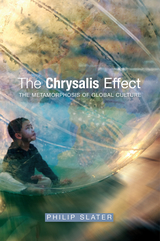 The Chrysalis Effect: The Metamorphosis of Global Culture
Philip Slater
Sussex Academic Press, 2022 The Chrysalis Effect shows that the chaos and conflict experienced worldwide today are the result of a global cultural metamorphosis, one which has accelerated so rapidly in recent decades as to provoke fierce resistance. Many of the changes that have taken place in the last fifty years - the feminist movement, the rapid spread of democracy, the global economy, quantum physics, minority movements, the peace movement, the sexual revolution - are part of this cultural transformation. Contrary to accepted opinion, the conflict it engenders is not a struggle between Left and Right, nor between the West and Islam, but one taking place within the Left, within the Right, within the West, within Islam, within everyone and every institution. Currently, the world is in the middle of an adaptive process, moving toward a cultural ethos more appropriate to a species living in a shrinking world and in danger of destroying its habitat - a world that increasingly demands for its survival, integrative thinking, unlimited communication, and global cooperation. Philip Slater - author of the bestselling The Pursuit of Loneliness and nine other nonfiction books - explains the metamorphosis of global culture through the analogy of the transition from caterpillar to butterfly - the Chrysalis Effect - whereby old cultural assumptions are challenged while innovations are seen as a social ill, a critical moral infection, and attacked as such by the upholders of tradition. And when the budding culture replaces the previous one, it doesn't create a new way of being out of nothing, but merely rearranges old patterns to make the new ones. Today, our world is caught in the middle of this disturbing transformative process - a process that creates confusion over values, loss of ethical certainty, and a bewildering lack of consensus about almost everything. The Chrysalis Effect provides an answer to the question: Why is the world in such a mess?
CHS vol 1 num 1
The University of Chicago Press
University of Chicago Press Journals, 2014
CHS vol 1 num 2
The University of Chicago Press
University of Chicago Press Journals, 2014
CHS vol 2 num 1
The University of Chicago Press
University of Chicago Press Journals, 2015
CHS vol 2 num 2
The University of Chicago Press
University of Chicago Press Journals, 2015
CHS vol 3 num 1
The University of Chicago Press
University of Chicago Press Journals, 2016
CHS vol 3 num 2
The University of Chicago Press
University of Chicago Press Journals, 2016
CHS vol 4 num 1
The University of Chicago Press
University of Chicago Press Journals, 2017
CHS vol 4 num 2
The University of Chicago Press
University of Chicago Press Journals, 2017
CHS vol 5 num 1
The University of Chicago Press
University of Chicago Press Journals, 2018
CHS vol 5 num 2
The University of Chicago Press
University of Chicago Press Journals, 2018
CHS vol 6 num 1
The University of Chicago Press
University of Chicago Press Journals, 2019
CHS vol 6 num 2
The University of Chicago Press
University of Chicago Press Journals, 2019
CHS vol 7 num 1
The University of Chicago Press
University of Chicago Press Journals, 2020
CHS vol 7 num 2
The University of Chicago Press
University of Chicago Press Journals, 2020
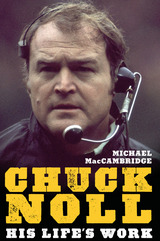 Chuck Noll: His Life's Work
Michael MacCambridge
University of Pittsburgh Press, 2016 Chuck Noll won four Super Bowls and presided over one of the greatest football dynasties in history, the Pittsburgh Steelers of the ‘70s. Later inducted into the Pro Football Hall of Fame, his achievements as a competitor and a coach are the stuff of legend. But Noll always remained an intensely private and introspective man, never revealing much of himself as a person or as a coach, not even to the players and fans who revered him.
Chuck Noll did not need a dramatic public profile to be the catalyst for one of the greatest transformations in sports history. In the nearly four decades before he was hired, the Pittsburgh Steelers were the least successful team in professional football, never winning so much as a division title. After Noll’s arrival, his quiet but steely leadership quickly remolded the team into the most accomplished in the history of professional football. And what he built endured well beyond his time with the Steelers – who have remained one of America’s great NFL teams, accumulating a total of six Super Bowls, eight AFC championships, and dozens of division titles and playoff berths.
In this penetrating biography, based on deep research and hundreds of interviews, Michael MacCambridge takes the measure of the man, painting an intimate portrait of one of the most important figures in American football history. He traces Noll’s journey from a Depression-era childhood in Cleveland, where he first played the game in a fully integrated neighborhood league led by an African-American coach and then seriously pursued the sport through high school and college. Eventually, Noll played both defensive and offensive positions professionally for the Browns, before discovering that his true calling was coaching. MacCambridge reveals that Noll secretly struggled with and overcame epilepsy to build the career that earned him his place as “the Emperor” of Pittsburgh during the Steelers’ dynastic run in the 1970s, while in his final years, he battled Alzheimer’s in the shelter of his caring and protective family.
Noll’s impact went well beyond one football team. When he arrived, the city of steel was facing a deep crisis, as the dramatic decline of Pittsburgh’s lifeblood industry traumatized an entire generation. “Losing,” Noll said on his first day on the job, “has nothing to do with geography.” Through his calm, confident leadership of the Steelers and the success they achieved, the people of Pittsburgh came to believe that winning was possible, and their recovery of confidence owed a lot to the Steeler’s new coach. The famous urban renaissance that followed can only be understood by grasping what Noll and his team meant to the people of the city. The man Pittsburghers could never fully know helped them see themselves better.
Chuck Noll: His Life’s Work tells the story of a private man in a very public job. It explores the family ties that built his character, the challenges that defined his course, and the love story that shaped his life. By understanding the man himself, we can at last clearly see Noll’s profound influence on the city, players, coaches, and game he loved. They are all, in a real sense, heirs to the football team Chuck Noll built.
Chuck Wagon Cookbook
Beth McElfresh
Ohio University Press, 1960
No chuck wagon feed is complete without its basic ingredients of beans, beef, hot biscuits, apple pie, and lots of coffee. Beth McElfresh shows you how to host the all–time chuck wagon feed with easy–to–follow recipes.
Included are original recipes for boiled apple dumplings, lima beans baked with steak, and general, everyday useful tips, all from the renowned Western cook, Hi Pockets. She describes various health remedies learned from the old–timers on the range, that are as useful today as they were then.
Also included are recipes showing you how to create actual hand lotion and soaps like those used in the rugged west; wines, tea, punch, even candy and ice cream are included.
Chuck Wagon Cookin'
Stella Hughes
University of Arizona Press, 1974 Chili, stew, biscuits—it's all here in over a hundred old-time recipes, home remedies too! More than a cookbook, it's a treasure trove of ranch lore.
"This is a splendid collection of cowcamp cook tales and 112 authentic old-time dutch oven recipes." —Books of the Southwest
"It is a delightful combination of yarns, history, nostalgia, and solid information—all ingeniously brewed up and spiced by a lady who knows what she is about." —Journal of Arizona History
"We haven't had a book that was so much fun to read in a long time." —Journal of the West
"If you want a good change in your eating, this is the book for you." —True West
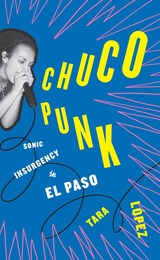 Chuco Punk: Sonic Insurgency in El Paso
Tara López
University of Texas Press, 2024 2025 Al Lowman Memorial Prize, Texas State Historical Association An immersive study of the influential and predominantly Chicanx punk rock scene in El Paso, Texas. Punk rock is known for its daring subversion, and so is the West Texas city of El Paso. In Chuco Punk, Tara López dives into the rebellious sonic history of the city, drawing on more than seventy interviews with punks, as well as unarchived flyers, photos, and other punk memorabilia. Connecting the scene to El Paso's own history as a borderland, a site of segregation, and a city with a long lineage of cultural and musical resistance, López throws readers into the heat of backyard punx shows, the chaos of riots in derelict mechanic shops, and the thrill of skateboarding on the roofs of local middle schools. She reveals how, in this predominantly Chicanx punk rock scene, women forged their own space, sound, and community. Covering the first roots of Chuco punk in the late 1970s through the early 2000s, López moves beyond the breakout bands to shed light on how the scene influenced not only the contours of sound and El Paso but the entire topography of punk rock.
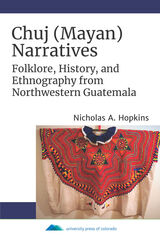 Chuj (Mayan) Narratives: Folklore, History, and Ethnography from Northwestern Guatemala
Nicholas A. Hopkins
University Press of Colorado, 2020 The Chuj of northwestern Guatemala are among the least studied groups of the Mayan family, and their relative isolation has preserved a strong indigenous tradition of storytelling. In Chuj (Mayan) Narratives, Nicholas Hopkins analyzes six narratives that illustrate the breadth of the Chuj storytelling tradition, from ancient mythology to current events and from intimate tales of local affairs to borrowed stories, such as an adaptation of Oedipus Rex.
The book illustrates the broad range of stories people tell each other, from mythological and legendary topics to procedural discussions and stories borrowed from European and African societies. Hopkins provides context for the narratives by introducing the reader to Chuj culture and history, conveying important events as described by indigenous participants. These events include customs and practices related to salt production as well as the beginnings of the disastrous civil war of the last century, which resulted in the destruction of several villages from which the narratives in this study originated. Hopkins also provides an analytical framework for the strategies of the storytellers and presents the narratives with Chuj text and English translation side-by-side.
Chuj (Mayan) Narratives analyzes the strategies of storytelling in an innovative framework applicable to other corpora and includes sufficient grammatical information to function as an introduction to the Chuj language. The stories illustrate the persistence of Classic Maya themes in contemporary folk literature, making the book significant to Mesoamericanists and Mayanists and an essential resource for students and scholars of Maya linguistics and literary traditions, storytelling, and folklore.
Church and Belief in the Middle Ages: Popes, Saints, and Crusaders
Edited by Kirsi Salonen and Sari Katajala-Peltomaa
Amsterdam University Press, 2016 The roles of popes, saints, and crusaders were inextricably intertwined in the Middle Ages: papal administration was fundamental in the making and promulgating of new saints and in financing crusades, while crusaders used saints as propaganda to back up the authority of popes, and even occasionally ended up being sanctified themselves. Yet, current scholarship rarely treats these three components of medieval faith together. This book remedies that by bringing together scholars to consider the links among the three and the ways that understanding them can help us build a more complete picture of the working of the church and Christianity in the Middle Ages.
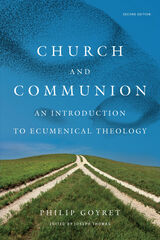 Church and Communion: An Introduction to Ecumenical Theology, Second Edition
Philip Goyret
Catholic University of America Press, 2021 This book is about ecumenism, from a Catholic point of view. The first part, chapters 1 and 2, describe the history of divisions within the Church, as well as of the efforts to bring about Christian unity. The second part examines Ecumenism from a systematic theological perspective.
This first part takes into account the different factors that led to definitive ruptures within the Church, which usually are not only theological. The text gives useful information about what happened after the respective divisions as well as about the various attempts to restore unity, the development of the Ecumenical Movement in the 20th Century, and the current situation of ecumenical dialogue within the Catholic Church. While offering insight into the sad history that has led to the present disunity, this work also highlights the way Christians have sought to bring to fulfill the petition of Christ that his disciples might be one, as He and the Father are one.
The second part―chapters three, four and five―offers a systematic theological analysis of unity in the Church, from the point of view of dogmatic theology. We find here an explanation of the Catholic concept of ecumenism, of how Catholic theology understands the unity of the Church, and, finally, of the Catholic principles which sustain the efforts for regaining unity in the Church. The Second Vatican Council, and particularly the Constitution Lumen gentium and the Decree Unitatis redintegratio, are at the foundation of these reflections. At the same time, since the theology of the Church and the life of the Church are intimately connected, there is a profound link between this dogmatic section and the earlier historical section.
The last chapter, about the practice of ecumenism, is also written from a theological perspective, but with more links with life and spirituality. The chapter recalls that ecumenism can never simply remain a set of theological principles, but rather inspires an attitude and action in charity which are essential to the Christian life.
 The Church and Galileo
Ernan McMullin
University of Notre Dame Press, 2005 This collection of first-rate essays aims to provide an accurate scholarly assessment of the relationship between the Roman Catholic Church and Galileo. In 1981, Pope John Paul II established a commission to inquire into the Church’s treatment of Galileo "in loyal recognition of wrongs, from whatever side they came," hoping this way to "dispel the mistrust . . . between science and faith." When the Galileo Commission finally issued its report in 1992, many scholars were disappointed by its inadequacies and its perpetuation of old defensive stratagems. This volume attempts what the Commission failed to provide—a historically accurate, scholarly, and balanced account of Galileo and his difficult relationship with the Roman Catholic Church.
Contributors provide careful analyses of the interactions of the Church and Galileo over the thirty years between 1612 and his death in 1642. They also explore the attitudes of theologians to the Copernican innovation prior to Galileo's entry into the fray; survey the political landscape within which he lived; assess the effectiveness (or otherwise) of censorship of his work; and provide an analysis and occasional critique of the Church’s later responses to the Galileo controversy. The book is divided into three sections corresponding to the periods before, during, and after the original Galileo affair. Particular attention is paid to those topics that have been the most divisive among scholars and theologians. The Church and Galileo will be welcomed by all those interested in early modern history and early modern science.
"This is an exciting book. Ernan McMullin has brought together an international group of scholars to reflect on and reevaluate the seminal confrontation between Galileo and the Church, from the point of view of both Galileo and his ecclesiastical antagonists. In a series of thirteen essays, the authors offer new interpretations of the events, their background and their significance, in a number of cases based on newly released material from the Vatican archives. Together these essays illuminate not only Galileo and his context, but larger questions about the relations among theology, the study of nature, and religious and political institutions in the age of the Scientific Revolution and beyond." —Daniel Garber, Princeton University
"The ‘Galileo affair’ has been the object of innumerable studies, which (taken as a whole) have spread nearly as much fog as they have sunshine. The studies in this volume, many of them based at least in part on newly discovered or released sources, have convincingly blown away much of that fog. This is easily the most important volume on the ‘Galileo affair’ ever produced." —David C. Lindberg, University of Wisconsin
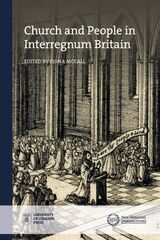 Church and People in Interregnum Britain
Edited by Fiona McCall
University of London Press, 2021 The English Civil War was followed by a period of unprecedented religious tolerance and the spread of new religious ideas and practices. Britain experienced a period of so-called “Godly religious rule” and a breakdown of religious uniformity that was perceived as a threat to social order by some and a welcome innovation to others. The period of Godly religious rule has been significantly neglected by historians—we know remarkably little about religious organization or experience at a parochial level in the 1640s and 1650s. This volume addresses these issues by investigating important questions concerning the relationship between religion and society in the years between the first Civil War and the Restoration. How did ordinary people experience this period of dramatic upheaval? How did religious imperatives change and develop? Did people resist Godly imperatives?With its nuanced analysis of Cromwell's England, Church and People in Interregnum Britain will interest religious scholars, enthusiasts of military history, and public historians.
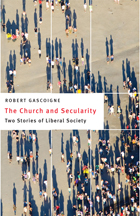 The Church and Secularity: Two Stories of Liberal Society
Robert Gascoigne
Georgetown University Press, 2009 Western liberal societies are characterized by two stories: a positive story of freedom of conscience and the recognition of community and human rights, and a negative story of unrestrained freedom that leads to self-centeredness, vacuity, and the destructive compromise of human values. Can the Catholic Church play a more meaningful role in assisting liberal societies in telling their better story? Australian ethicist Robert Gascoigne thinks it can. In The Church and Secularity he considers the meaning of secularity as a shared space for all citizens and asks how the Church can contribute to a sensitivity to—and respect for—human dignity and human rights. Drawing on Augustine’s City of God and Vatican II’s Gaudium et spes, Gascoigne interprets the meaning of freedom in liberal societies through the lens of Augustine’s “two loves,” the love of God and neighbor and the love of self, and reveals how the two are connected to our contemporary experience. The Church and Secularity argues that the Church can serve liberal societies in a positive way and that its own social identity, rooted in Eucharistic communities, must be bound up with the struggle for human rights and resistance to the commodification of the human in all its forms.
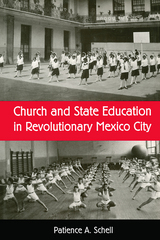 Church and State Education in Revolutionary Mexico City
Patience A. Schell
University of Arizona Press, 2003 Revolution in Mexico sought to subordinate church to state and push the church out of public life. Nevertheless, state and church shared a concern for the nation's social problems. Until the breakdown of church-state cooperation in 1926, they ignored the political chasm separating them to address those problems through education in order to instill in citizens a new sense of patriotism, a strong work ethic, and adherence to traditional gender roles. This book examines primary, vocational, private, and parochial education in Mexico City from 1917 to 1926 and shows how it was affected by the relations between the revolutionary state and the Roman Catholic Church. One of the first books to look at revolutionary programs in the capital immediately after the Revolution, it shows how government social reform and Catholic social action overlapped and identifies clear points of convergence while also offering vivid descriptions of everyday life in revolutionary Mexico City. Comparing curricula and practice in Catholic and public schools, Patience Schell describes scandals and successes in classrooms throughout Mexico City. Her re-creation of day-to-day schooling shows how teachers, inspectors, volunteers, and priests, even while facing material shortages, struggled to educate Mexico City's residents out of a conviction that they were transforming society. She also reviews broader federal and Catholic social action programs such as films, unionization projects, and libraries that sought to instill a new morality in the working class. Finally, she situates education among larger issues that eventually divided church and state and examines the impact of the restrictions placed on Catholic education in 1926. Schell sheds new light on the common cause between revolutionary state education and Catholic tradition and provides new insight into the wider issue of the relationship between the revolutionary state and civil society. As the presidency of Vicente Fox revives questions of church involvement in Mexican public life, her study provides a solid foundation for understanding the tenor and tenure of that age-old relationship.
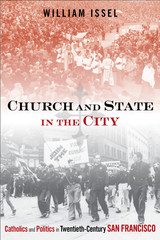 Church and State in the City: Catholics and Politics in Twentieth-Century San Francisco
William Issel
Temple University Press, 2012 Church and State in the City provides the first comprehensive analysis of the city’s long debate about the public interest. Historian William Issel explores the complex ways that the San Francisco Catholic Church—and its lay men and women—developed relationships with the local businesses, unions, other community groups, and city government to shape debates about how to define and implement the common good. Issel’s deeply researched narrative also sheds new light on the city’s socialists, including Communist Party activists—the most important transnational challengers of both capitalism and Catholicism during the twentieth century. Moreover, Church and State in the City is revisionist in challenging the notion that the history of urban politics and policy can best be understood as the unfolding of a progressive, secular modernization of urban political culture. Issel shows how tussles over the public interest in San Francisco were both distinctive to the city and shaped by its American character. In the series Urban Life, Landscape, and Policy, edited by Zane L. Miller, David Stradling, and Larry Bennett
The Church and the Land: The National Catholic Rural Life Conference and American Society, 1923–2007
David S. Bovée
Catholic University of America Press, 2010 The Church and the Land is the first scholarly history of the Catholic rural life movement in the United States from its beginning in the 1920s to the present day. It tells the story of the men and women of the National Catholic Rural Life Conference (NCRLC) who labored to bring Catholic principles into effect to benefit the farm families, agricultural laborers, and others who lived in the American countrysid
 The Church and the Left
Adam Michnik
University of Chicago Press, 1992 Writing in The New Republic, Nobel laureate Czeslaw Milosz said of Adam Michnik, "Before his unbending will, which pushes him to pay with his own person every time he encounters injustice. I feel what probably was felt by an average Hindu confronted by the devotion of Gandhi: admiration mixed with incredulity and hope. . . . Michnik is one of those who bring honor to the last two decades of the twentieth century."
Years in advance of the collapse of communism in Eastern Europe, Poland underwent one of the most radical and painful social and political upheavals of our century. Through a wide body of writing and an unswerving political commitment that took him from prison to parliament, Adam Michnik was a central figure in these events—culminating in 1989 with his role in formulating the political deal that brought Solidarity to power. Michnik's writings, most of them smuggled out of prison, have been translated into many languages; but until now, only isolated essays have appeared in English.
In The Church and the Left, Michnik gives full expression to the ideas that have shaped the drama of Poland and of our time. The unlikely alliance of the Catholic Church and the dissident Left is one of the most fascinating and confusing features of the Polish revolutionary movement. No other book better explains the logic of this powerful coalition—or its future implications. In superb discussions of liberalism and nationalism, of secularism and clericalism, Michnik illuminates the unique makeup and direction of Poland's social revolution and, at the same time, offers unparalleled insight into the internal struggles still present in Eastern Europe.
Today, as religious revivals proliferate and secular progress, whether liberal or communist, comes under suspicion, the relationship of religion to politics has become a pressing issue far beyond the boundaries of Poland. As none has done before, Michnik's clear and thoughtful book gives us the means to understand this volatile mix as it has transformed Poland and as it figures in the future we see taking shape.
The Church Confronts Modernity
Leslie Woodcock Tentler
Catholic University of America Press, 2007 The Church Confronts Modernity assesses the history of Roman Catholicism since 1950 in the United States, the Republic of Ireland, and the Canadian province of Quebec
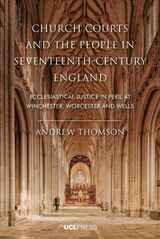 Church Courts and the People in Seventeenth-Century England: Ecclesiastical Justice in Peril at Winchester, Worcester and Wells
Andrew Thomson
University College London, 2022 An exploration of the regulatory and coercive roles played by church courts in England during the seventeenth century.
Religion meant far more in early modern England than church on Sundays, a baptism, a funeral, or a wedding ceremony. The Church was fully enmeshed in the everyday lives of the people, their morals, and religious observance. It imposed comprehensive regulations on its flock focused on such issues as sex before marriage, adultery, and receiving the sacrament, and it employed an army of informers and bureaucrats, headed by a diocesan chancellor, to enable its courts to enforce the rules. Church courts lay, thus, at the very intersection of Church and people. This book offers a detailed survey of three dioceses across the whole of the century, examining key aspects such as attendance at court, completion of business, and, crucially, the scale of guilt to test the performance of the courts. For students and researchers of the seventeenth century, it provides a full account of court operations, measuring the extent of control, challenging orthodoxies about ex-communication, penance, and juries, contextualizing ecclesiastical justice within major societal issues of the times, and, ultimately, presents powerful evidence for a “church in danger” by the end of the century.
Church History in an Age of Uncertainty: Historiographical Patterns in the United States, 1906 - 1990
Henry Warner Bowden
Southern Illinois University Press, 1991
Essential to Catholic, Protestant, and even secular scholars of American religious history this is the first historiographical analysis of the work of Henry K. Rowe, James H. Nichols, Leonard J. Trinterud, H. Shelton Smith, John T. McNeill, Herbert W. Schneider, Robert T. Handy, John T. Ellis, and Jaroslav Pelikan.
Aware that every generation rewrites history, Bowden bases his investigation of major twentieth-century church historians on two questions: Why are young historians dissatisfied with earlier treatments? What leads them to believe their version is better?
Henry Warner Bowden’s extensive bibliography includes A Century of Church History: The Legacy of Philip Schaff.
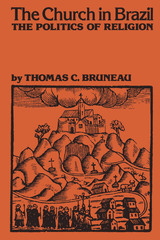 The Church in Brazil: The Politics of Religion
By Thomas C. Bruneau
University of Texas Press, 1982 In 1980, Brazil was the largest Roman Catholic country in the world, with 90 percent of its more than 120 million people numbered among the faithful. The Church hierarchy became aware, however, that the religion practiced by the majority of its members was not that promoted by the institution, a point dramatized by the rapid growth of other religious movements in Brazil—particularly Protestant sects and spirit-possession cults. In response, the Church created and assumed new roles. The Church in Brazil is a case study of the changes within the Church and their impact on Brazilian society. In an original and illuminating discussion, Thomas Bruneau combines institutional analysis and survey data to explore the relationship between structural changes in the Church and evolving patterns of practice and belief. His discussion displays the richness and variety of devotion in Brazil—characteristics recognized by many observers—and examines the Church's potential for influencing the people's religious life. Moving from the historical and national to the regional, Bruneau analyzes and compares changes among eight dioceses. He concludes that the Church is actively promoting a progressive social role for itself and, by backing its statements with actions, is perceived as being socially effective by both supporters and opponents. The first study in which the national and diocesan levels of the Church are analyzed together, it is also the first to inspect systematically the Basic Christian Communities, thought by some to be the most significant grass-roots movement in the Catholic world of that time.
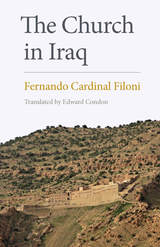 The Church in Iraq
Fernando Cardinal Filoni
Catholic University of America Press, 2017 The persecution of the church in Iraq is one of the great tragedies of the twenty-first century. In this short, yet sweeping account, Cardinal Filoni, the former Papal Nuncio to Iraq, shows us the people and the faith in the land of Abraham and Babylon, a region that has been home to Persians, Parthians, Byzantines, Mongols, Ottomans, and more. This is the compelling and rich history of the Christian communities in a land that was once the frontier between Rome and Persia, for centuries the crossroads of East and West for armies of invaders and merchants, and the cradle of all human civilization. Its unique cultural legacy has, in the past few years, been all but obliterated.
The Church in Iraq is both a diligent record and loving testimonial to a community that is struggling desperately to exist. Filoni guides the reader through almost two thousand years of history, telling the story of a people who trace their faith back to the Apostle Thomas. The diversity of peoples and churches is brought deftly into focus through the lens of their interactions with the papacy, but The Church in Iraq does not shy away from discussing the local political, ethnic, and theological tensions that have resulted in centuries of communion and schism. Never losing his focus on the people to whom this book is so clearly dedicated, Cardinal Filoni has produced a personal and engaging history of the relationship between Rome and the Eastern Churches. This book has much to teach its reader about the church in the near East. Perhaps its most brutal lesson is the ease with which such a depth of history and culture can be wiped away in a few short decades.
 Church in the Wild: Evangelicals in Antebellum America
Brett Malcolm Grainger
Harvard University Press, 2019 A religious studies scholar argues that in antebellum America, evangelicals, not Transcendentalists, connected ordinary Americans with their spiritual roots in the natural world.
We have long credited Emerson and his fellow Transcendentalists with revolutionizing religious life in America and introducing a new appreciation of nature. Breaking with Protestant orthodoxy, these New Englanders claimed that God could be found not in church but in forest, fields, and streams. Their spiritual nonconformity had thrilling implications but never traveled far beyond their circle. In this essential reconsideration of American faith in the years leading up to the Civil War, Brett Malcolm Grainger argues that it was not the Transcendentalists but the evangelical revivalists who transformed the everyday religious life of Americans and spiritualized the natural environment.
Evangelical Christianity won believers from the rural South to the industrial North: this was the true popular religion of the antebellum years. Revivalists went to the woods not to free themselves from the constraints of Christianity but to renew their ties to God. Evangelical Christianity provided a sense of enchantment for those alienated by a rapidly industrializing world. In forested camp meetings and riverside baptisms, in private contemplation and public water cures, in electrotherapy and mesmerism, American evangelicals communed with nature, God, and one another. A distinctive spirituality emerged pairing personal piety with a mystical relation to nature.
As Church in the Wild reveals, the revivalist attitude toward nature and the material world, which echoed that of Catholicism, spread like wildfire among Christians of all backgrounds during the years leading up to the Civil War.
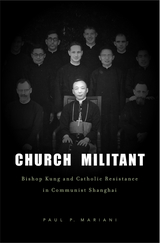 Church Militant: Bishop Kung and Catholic Resistance in Communist Shanghai
Paul P. Mariani
Harvard University Press, 2011 By 1952 the Chinese Communist Party had suppressed all organized resistance to its regime and stood unopposed, or so it has been believed. Internal party documents—declassified just long enough for historian Paul Mariani to send copies out of China—disclose that one group deemed an enemy of the state held out after the others had fallen. A party report from Shanghai marked “top-secret” reveals a determined, often courageous resistance by the local Catholic Church. Drawing on centuries of experience in struggling with the Chinese authorities, the Church was proving a stubborn match for the party.
Mariani tells the story of how Bishop (later Cardinal) Ignatius Kung Pinmei, the Jesuits, and the Catholic Youth resisted the regime’s punishing assault on the Shanghai Catholic community and refused to renounce the pope and the Church in Rome. Acting clandestinely, mirroring tactics used by the previously underground CCP, Shanghai’s Catholics persevered until 1955, when the party arrested Kung and 1,200 other leading Catholics. The imprisoned believers were later shocked to learn that the betrayal had come from within their own ranks.
Though the CCP could not eradicate the Catholic Church in China, it succeeded in dividing it. Mariani’s secret history traces the origins of a deep split in the Chinese Catholic community, where relations between the “Patriotic” and underground churches remain strained even today.
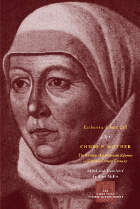 Church Mother: The Writings of a Protestant Reformer in Sixteenth-Century Germany
Katharina Schütz Zell
University of Chicago Press, 2006 Imbued with character and independence, strength and articulateness, humor and conviction, abundant biblical knowledge and intense compassion, Katharina Schütz Zell (1498–1562) was an outspoken religious reformer in sixteenth-century Germany who campaigned for the right of clergy to marry and the responsibility of lay people—women as well as men—to proclaim the Gospel. As one of the first and most daring models of the pastor’s wife in the Protestant Reformation, Schütz Zell demonstrated that she could be an equal partner in marriage; she was for many years a respected, if unofficial, mother of the established church of Strasbourg in an age when ecclesiastical leadership was dominated by men.
Though a commoner, Schütz Zell participated actively in public life and wrote prolifically, including letters of consolation, devotional writings, biblical meditations, catechetical instructions, a sermon, and lengthy polemical exchanges with male theologians. The complete translations of her extant publications, except for her longest, are collected here in Church Mother, offering modern readers a rare opportunity to understand the important work of women in the formation of the early Protestant church.
 The Church of Divine Electricity
Emily Mitchell
University of Wisconsin Press, 2025 Delightfully blending literary fiction with speculative genres, the stories in The Church of Divine Electricity somehow manage to feel as though they could take place today. In Emily Mitchell’s created worlds, as in our own, technology bewitches, especially with its ability to heighten both connections and isolation.
Whether being held by a giant and comforting machine, allowing micro-drones to record one’s every moment for a year to win prize money, or choosing self-mutilation in exchange for a bionic hand, these characters navigate technological and social change. The familiar can turn unrecognizable and disorienting—sometimes in a flash, sometimes gradually. Lyrical, haunting, and often funny, these stories ask us to consider what—and who—gets left out of a seemingly utopian future of technological advancements. Finely observed, thoughtful, and vivid, Mitchell’s stories get under your skin. It’s not that the best-laid plans could lead us astray—it’s that they may already have.
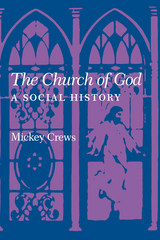 The Church of God: A Social History
Mickey Crews
University of Tennessee Press, 1990 This book delves into the remarkable rise of the Church of God, a Pentecostal denomination born in the rural mountains of Tennessee and North Carolina at the turn of the twentieth century. Emerging alongside the Populist movement, the church offered a distinct spiritual response to the anxieties of a rapidly changing society. The author meticulously traces the church's evolution from its humble beginnings to its current global reach, exploring its unique theology, strict moral code, and the development of its hierarchical structure. This journey unveils the intricate interplay between religious fervor, social class, and cultural context. Through vivid accounts of early members' experiences, the book illuminates the church's appeal as a close-knit community offering spiritual empowerment and a sense of belonging. It also sheds light on the challenges faced by the church, including internal conflicts and external persecution. Ultimately, this book offers a nuanced understanding of how the Church of God navigated the tensions between tradition and modernity, carving out a space for itself in the American religious landscape. Its insights into the dynamics of religious communities and the enduring power of faith resonate even today.
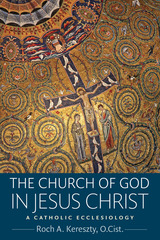 The Church of God in Jesus Christ : A Catholic Ecclesiology
Roch A. Kereszty
Catholic University of America Press, 2019 Investigating Vatican II is a collection of Fr. Jared Wicks’ recent articles on Vatican II, and presents the Second Vatican Council as an event to which theologians contributed in major ways and from which Catholic theology can gain enormous insights. Taken as a whole, the articles take the reader into the theological dynamics of Vatican II at key moments in the Council’s historical unfolding. Wicks promotes a contemporary re-reception of Vatican II’s theologically profound documents, especially as they featured God’s incarnate and saving Word, laid down principles of Catholic ecumenical engagement, and articulated the church’s turn to the modern world with a new “face” of respect and dedication to service. From the original motivations of Pope John XXIII in convoking the Council, Investigating Vatican II goes on to highlight the profound insights offered by theologians who served behind the scenes as Council experts. In its chapters, the book moves through the Council’s working periods, drawing on the published and non-published records, with attention to the Council’s dramas, crises, and breakthroughs. It brings to light the bases of Pope Francis’s call for synodality in a listening church, while highlighting Vatican II’s mandate to all of prayerful biblical reading, for fostering a vibrant “joy in the Gospel.”
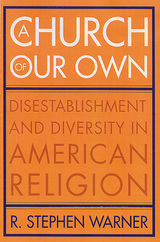 A Church of Our Own: Disestablishment and Diversity in American Religion
Warner, R. Stephen
Rutgers University Press, 2005 In this definitive collection of essays spanning fifteen years, R. Stephen Warner traces the development of the “new paradigm” interpretation of American religion. Originally formulated in the 1990s in response to prevailing theories of secularization that focused on the waning plausibility of religion in modern societies, the new paradigm reoriented the study of religion to a focus on communities, subcultures, new religious institutions, and the fluidity of modern religious identities. This perspective continues to be one of the most important driving forces in the field and one of the most significant challenges to the idea that religious pluralism inevitably leads to religious decline.
A leading sociologist of religion, Warner shows how the new paradigm stresses the role that religion plays as a vehicle for the bonding and expression of communities within the United States—a society founded on the principle of religious disestablishment and characterized by a diverse and mobile population. Chapters examine evangelicals and Pentecostals, gay and lesbian churches, immigrant religious institutions, Hispanic parishes, and churches for the deaf in terms of this framework. Newly written introductory and concluding essays set these groups within the broad context of the developing field. A thoughtfully organized and timely collection, the volume is a valuable classroom resource as well as essential reading for scholars of contemporary religion.
 The Church of the Holy Spirit
Nicholas Afanasiev
University of Notre Dame Press, 2007
The Church of the Holy Spirit, written by Russian priest and scholar Nicholas Afanasiev (1893–1966), is one of the most important works of twentieth-century Orthodox theology. Afanasiev was a member of the “Paris School” of émigré intellectuals who gathered in Paris after the Russian revolution, where he became a member of the faculty of St. Sergius Orthodox Seminary. The Church of the Holy Spirit, which offers a rediscovery of the eucharistic and communal nature of the church in the first several centuries, was written over a number of years beginning in the 1940s and continuously revised until its posthumous publication in French in 1971.
Vitaly Permiakov's lucid translation and Michael Plekon's careful editing and substantive introduction make this important work available for the first time to an English-speaking audience.
"Nicholas Afanasiev is perhaps the most important ecclesiologist of modern times in the Orthodox world. The Church of the Holy Spirit is a very important book, a magnum opus, demonstrating that Afanasiev himself is undoubtedly a major twentieth-century theologian.” —John McGuckin, Nielsen Professor of Early Ecclesiastical History, Union Theological Seminary
“One of the great contributions of the Second Vatican Council was its recovery of a Eucharistic ecclesiology. Yet over a decade before the council, one of the most influential theologians of the Eastern Orthodox communion, Nicholas Afanasiev, was helping his own tradition recover its Eucharistic foundations. The publication of one of his most significant works, The Church of the Holy Spirit, which the University of Notre Dame Press has now made available in English translation, will allow contemporary readers to discover the provocative, insightful and sometimes idiosyncratic perspectives of this seminal Orthodox theologian.” —Richard R. Gaillardetz, Murray/Bacik Professor of Catholic Studies, University of Toledo.
“Fr. Nicholas Afanasiev's The Church of the Holy Spirit is truly a seminal work of the twentieth-century, an indispensable monument of theological reflection on the Church and her Liturgy. Written over many years, in sustained engagement with the historical experience of the Church and contemporary Eastern and Western theology, the work became itself a catalyst in both eucharistic practice and ecclesiological reflection. This splendid English translation will provide the opportunity for Afanasiev's contribution to be more fully appreciated and critically appropriated.” —Rev. Dr. John Behr, Dean, St Vladimir's Orthodox Theological Seminary
The Church of the Panaghia tou Arakos at Lagoudhera, Cyprus: The Paintings and Their Painterly Significance
David Winfield and June Winfield
Harvard University Press, 2003 The monastery church at Lagoudhera, Cyprus, is notable for an almost complete decoration of Byzantine wall painting, dated to 1192. These paintings present the finest surviving example of the elegant linear style of the second half of the twelfth century. In this work, David and June Winfield discuss the language of Byzantine church decoration, methods of plastering, proportional rules, system of coloring, and the working methods of the Byzantine painter.
 Church, Politics, and Society in Spain, 1750-1874
William J. Callahan
Harvard University Press, 1984 This contribution to European historical literature--based on extensive research in Madrid--provides a clear and dispassionate account of successive ecclesiastical-secular conflicts and controversies, and deftly summarizes the diverse ideological and intellectual currents of the times.
Nowhere in Europe has the Roman Catholic Church exerted a more mystical hold on the life of a nation than it has in Spain. Yet this hold has not been unchanging or unchallenged. By the mid-eighteenth century the Church was no longer the only legitimate source of authority, the all-pervasive presence that it had been, most forcefully in the late fifteenth and sixteenth centuries. Still, its power remained formidable. The Spanish Church imposed standards of conduct over the entire range of society, from the aristocracy to the peasant masses, and it possessed the material resources necessary to maintain an elaborate ecclesiastical network that influenced every aspect of Spanish life.
The heart of the book deals with the reactions of the Church to the dramatic, sometimes violent, changes that occurred during the critical nineteenth-century period of national transition from royal absolutism to popular liberalism. The study examines the responses of the Church to the new social and political forces that could no longer be excluded or contained, among them an emergent secular--even anticlerical--culture and a developing capitalism.Callahan demonstrates that these changes engendered resentments and frustrations deep within the ecclesiastical order that persisted well into the twentieth century, notably with the Spanish Church's embrace of Franco.
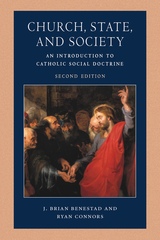 Church, State, and Society: An Introduction to Catholic Social Doctrine, Second Edition
J. Brian Benestad
Catholic University of America Press, 2025 Church, State, and Society explains the nuanced understanding of human dignity and the common good found in the Catholic intellectual tradition. It makes the case that liberal-arts education is an essential part of the common good because it helps people understand their dignity and all that justice requires.
The book is divided into four parts. The first treats key themes of social life: the dignity of the human person, human rights, natural law, and the common good. Part two focuses on the three principal mediating institutions of civil society: the family, the Church, and the Catholic university. Part three considers the economy, work, poverty, immigration, and the environment, while part four focuses on the international community and just war principles. The conclusion discusses tension between Catholic Social Doctrine and liberal democracy.
This second edition contains new chapters on religious liberty, cooperation with evil, issues around gender ideology, and contemporary questions of Catholics in political life, including regarding the reception of the sacraments. The book also includes new material on economic and social teaching of the Magisterium promulgated since the first edition, especially related to the teaching of Benedict XVI.
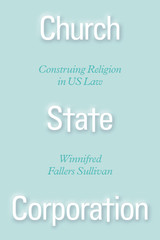 Church State Corporation: Construing Religion in US Law
Winnifred Fallers Sullivan
University of Chicago Press, 2020 Church and state: a simple phrase that reflects one of the most famous and fraught relationships in the history of the United States. But what exactly is “the church,” and how is it understood in US law today? In Church State Corporation, religion and law scholar Winnifred Fallers Sullivan uncovers the deeply ambiguous and often unacknowledged ways in which Christian theology remains alive and at work in the American legal imagination.
Through readings of the opinions of the US Supreme Court and other legal texts, Sullivan shows how “the church” as a religious collective is granted special privilege in US law. In-depth analyses of Hosanna-Tabor v. EEOC and Burwell v. Hobby Lobby reveal that the law tends to honor the religious rights of the group—whether in the form of a church, as in Hosanna-Tabor, or in corporate form, as in Hobby Lobby—over the rights of the individual, offering corporate religious entities an autonomy denied to their respective members. In discussing the various communities that construct the “church-shaped space” in American law, Sullivan also delves into disputes over church property, the legal exploitation of the black church in the criminal justice system, and the recent case of Masterpiece Cakeshop v. Colorado Civil Rights Commission. Brimming with insight, Church State Corporation provocatively challenges our most basic beliefs about the ties between religion and law in ostensibly secular democracies.
The Church, the Councils, and Reform: The Legacy of the Fifteenth Century
Gerald Christianson
Catholic University of America Press, 2008 The Church, the Councils, and Reform brings together leading authorities in the field of church history to reflect on the importance of the late medieval councils. This is the first book in English to consider the lasting significance of the period from Constance to Trent (1414-1563) when several councils met to heal the Great Schism (1378) and reform the church.
Churches
Kevin Prufer
Four Way Books, 2014 Churches explores the way our experience of the world is shaped through the stories we tell about ourselves. These poems braid multiple narratives that often take place in different times, or are seen through the eyes of various speakers. Here Prufer explores the interior and subjective nature of time as he engages with mortality, both as a cultural construct and a deeply personal, unarticulatable anxiety: “In this filtered light, / my brain is a nimbler thing, and strange. It loves / the slow derangements distance brings.”
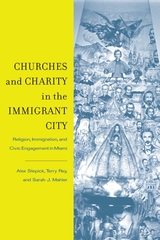 Churches and Charity in the Immigrant City: Religion, Immigration, and Civic Engagement in Miami
Stepick, Alex
Rutgers University Press, 2009 In addition to being a religious country--over ninety percent of Americans believe in God--the United States is also home to more immigrants than ever before. Churches and Charity in the Immigrant City focuses on the intersection of religion and civic engagement among Miami's immigrant and minority groups. The contributors examine the role of religious organizations in developing social relationships and how these relationships affect the broader civic world. Essays, for example, consider the role of leadership in the promotion and creation of "civic social capital" in a Haitian Catholic church, transnational ties between Cuban Catholics in Miami and Havana, and several African American congregations that serve as key comparisons of civic engagement among minorities. This book is important not only for its theoretical contributions to the sociology of religion, but also because it gives us a unique glimpse into immigrants' civic and religious lives in urban America.
 Churches and States: Studies on the History of Christianity in Ukraine
Halyna Hryn
Harvard University Press This book collects nine articles that originally appeared in the journal Harvard Ukrainian Studies and that arose from the Harvard Ukrainian Research Institute’s Millennium Project, an initiative launched in the 1980s to celebrate one thousand years of the Christianization of Kyivan Rus´. The articles cover a wide array of subjects: the ecclesiastical structure of the Christian Church in Rus´ in its earliest period (Andrzej Poppe); the conflict between Orthodoxy and the Uniate Church from 1569 to 1700 (Teresa Chynczewska-Hennel); an account of the Uniate Church and the partitions of Poland (Larry Wolff); the transformation of the Greek Catholic Church under the Austrian Empire (1848–1914) (John-Paul Himka); the Greek Catholic Church in the period between the two World Wars (Andrew Sorokowski); a rethinking of the relationship of Church and society in Galician Ukraine from 1914 to 1944 (Bohdan Budurowycz); and the Russian Orthodox Church in Ukraine during the interwar period (Bohdan Bociurkiw). The book concludes with a bio-bibliography of Bohdan Bociurkiw, a scholar who devoted his career to the study of Ukrainian Church history (Andrii Krawchuk). These essays provide new insights and a fresh perspective to the discipline.
 Churches EA and E at Sardis
Hans Buchwald
Harvard University Press, 2015 Sardis was home to one of the earliest known Christian communities, appearing among the Seven Churches of Asia in the mid-first century AD. Between 1962 and 1973, the Archaeological Exploration of Sardis excavated two superimposed churches at the ancient site, one early Christian, one Byzantine. This richly illustrated volume documents the architecture and history of these buildings from the fourth to the sixteenth century.
The early Christian church, an aisled basilica with narthex and atrium, both decorated with floor mosaics, had a long and complicated history, starting in the fourth century and continuing into the ninth century. Built over its remains is a Byzantine church dating to the little-known Lascarid period, when Constantinople had fallen to the Fourth Crusade and western Asia Minor was home to an independent Christian empire. This building’s standing remains, scattered domes, and vaulting fragments support the reconstruction of an inscribed-cross church with six columns and five domes, enriched on the exterior by a variety of brick and terracotta decoration. Together, these buildings cast new light on a millennium of Christian worship at Sardis, from the first official recognition of Christianity until the end of the Byzantine era.
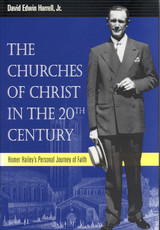 The Churches of Christ in the 20th Century: Homer Hailey's Personal Journey of Faith
David Edwin Harrell
University of Alabama Press, 2002 The story of one of this country's major religious movements is told through the spiritual odyssey of one of its prominent spokesmen. When Homer Hailey sparked controversy within Churches of Christ congregations over his stand on divorce and remarriage, he spoke to a movement already sundered. Historian David Edwin Harrell tells Hailey's story as a means of presenting the larger drama of faith and feuding within those churches.
A nondenominational movement of autonomous congregations, Churches of Christ have been among the fastest-growing religious bodies in the 20th century. Throughout the movement's history, church leaders debated issues ranging from missionary societies to the use of instrumental music in worship. Although some disagreements affected only the ties between congregations, others led to the creation of three distinct groups calling themselves Churches of Christ identified by their sociological and theological positions.
This book shows how the story of the Churches of Christ is reflected by Homer Hailey, a preacher, educator, and author whose life puts in perspective the personal journeys traveled by members in this century. Writing from the perspective of the non-institutional wing within the movement, Harrell avoids mainstream biases to describe the various dissenting views as fully and fairly as possible. Combining institutional history and biography, Harrell's book is the first to bring the story of the Churches of Christ to century's end. It provides new insight into how this movement realigned itself and shows how one man's career reflected a century of spiritual growth and change for the church as a whole.
Churchill
Sebastian Haffner
Haus Publishing, 2003 Winston Churchill (1874-1965, KG 1953) Conservative politician, Prime Minister 1940-5 and 1951-5. Perhaps the most determined and inspirational war leader in Britain's history, it was during that darkest summer of 1940 that Churchill's astonishing oratory seemed to rally the nation, from his opening statement to the House of Commons on May 13th that he had 'nothing to offer but blood, toil, tears and sweat'. Each successive crisis produced phrases that have resounded ever since, from the danger of invasion after the evacuation of troops from Dunkirk ('their finest hour') to the Battle of Britain (his tribute to the 'Few'). However, he lost the general election in June 1945. But he returned to Downing Street in 1951, finally retiring in 1955.
Churchill
Chris Wrigley
Haus Publishing, 2006 Part of the 20 Prime Ministers Series
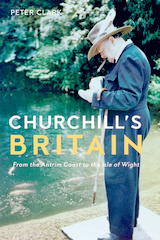 Churchill's Britain: From the Antrim Coast to the Isle of Wight
Peter Clark
Haus Publishing, 2023 Clark takes us on a geographical journey through Churchill's life, following his footsteps through Britain and Ireland.
More than half a century after his death, Winston Churchill, the most significant British statesman of the twentieth century, continues to intrigue us. Peter Clark’s book, however, is not merely another Churchill biography. Churchill’s Britain takes us on a geographical journey through Churchill’s life, leading us in Churchill’s footsteps through locations in Britain and Ireland that are tied to key aspects of his biography. Some are familiar–Blenheim Palace, where he was born; Chartwell, his beloved house in the country; and the Cabinet War Rooms, where he planned the campaigns of World War II. But we also are taken to his schools, his parliamentary constituencies, locations of famous speeches, the place where he started to paint, the tobacco shop where he bought his cigars, and the graves of his family and close friends.
Clark brings us close to the statesman Churchill by visiting sites that were important to the story of his long life, from the site where his father proposed to his American mother on the Isle of Wight to his grave in a country churchyard in Oxfordshire. Designed as a gazetteer with helpful regional maps, Churchill’s Britain can be dipped into, consulted by the traveler on a Churchill tour of Britain, or read straight through—and no matter how it’s read, it will deliver fresh insights into this extraordinary man.
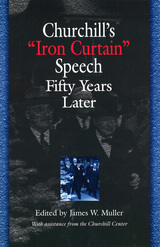 Churchill's "Iron Curtain" Speech Fifty Years Later
Edited & Intro by James W. Muller
University of Missouri Press, 1999
Winston Churchill's visit to Fulton, Missouri, on March 5, 1946, marked the first public recognition of the cold war that was to follow World War II. Churchill delivered his most famous speech, "The Sinews of Peace," which became best known by the phrase he used to describe the cold-war division of Europe, the "iron curtain."
In the United States and Britain, wartime alliances had fostered favorable feelings toward the Soviet Union. By 1946 democratic citizens on both sides of the Atlantic had begun to consider communist Russia a friend. In his speech at Fulton, Churchill exhibited breathtaking flexibility and a clear recognition of the main threat as he reminded the public that true friendship must be reserved for countries sharing a common love of liberty. The "Iron Curtain" speech defined postwar relations with the Soviet Union for citizens of Western democracies. Although it initially provoked intense controversy in the United States and Britain, criticism soon gave way to wide public agreement to oppose Soviet imperialism.
Opening with the full text of the address Churchill delivered in Fulton and concluding with Margaret Thatcher's fiftieth-anniversary address surveying the challenges facing Western democracies in this post-cold war climate, the book brings together essays that reflect on the past fifty years, recognizing Churchill's speech as a carefully conceived herald of the cold war for the Western democracies. These powerful essays offer a fresh appreciation of the speech's political, historical, diplomatic, and rhetorical significance.
 Churching Of America
Finke, Roger
Rutgers University Press, 1992
In this provocative book, Roger Finke and Rodney Stark challenge popular perceptions about American religion. They view the religious environment as a free market economy, where churches compete for souls. The story they tell is one of gains for upstart sects and losses for mainline denominations. Although many Americans assume that religious participation has declined in America, Finke and Stark present a different picture. In 1776, fewer than 1 in 5 Americans were active in church affairs. Today, church membership includes about 6 out of 10 people. But, as Finke and Stark show, not all denominations benefited from this growth. They explain how and why the leading eighteenth-century churches began their descent, while two newcomer sects, the Baptists and the Methodists, gained ground. They also analyze why the Methodists then began a long, downward slide, why the Baptists continued to succeed, how the Catholic Church met the competition of ardent Protestant missionaries, and why the Catholic commitment has declined since Vatican II. The authors also explain why ecumenical movements always fail. In short, Americans are not abandoning religion; they have been moving away from established denominations. A "sect-church process" is always under way, Finke and Stark argue, as successful churches lose their organizational vigor and are replaced by less worldly groups. Some observers assert that the rise in church membership rates indicates increased participation, not increased belief. Finke and Stark challenge this as well. They find that those groups that have gained the greatest numbers have demanded that their followers accept traditional doctrines and otherworldliness. They argue thatreligious organizations can thrive only when they comfort souls and demand sacrifice. When theology becomes too logical, or too secular, it loses people.
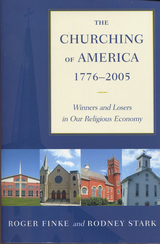 The Churching of America, 1776-2005: Winners and Losers in Our Religious Economy
Finke, Roger
Rutgers University Press, 2005 Although many Americans assume that religious participation has declined in America, Finke and Stark present a different picture. In 1776, fewer than 1 in 5 Americans were active in church affairs. Today, church membership includes about 6 out of 10 people.
But, as Finke and Stark show, not all denominations benefited. They explain how and why the early nineteenth-century churches began their descent, while two newcomer sects, the Baptists and the Methodists, gained ground. They also analyze why the Methodists then began a long, downward slide, why the Baptists continued to succeed, how the Catholic Church met the competition of ardent Protestant missionaries, and why the Catholic commitment has declined since Vatican II. The authors also explain why ecumenical movements always fail
In short, Americans are not abandoning religion; they have been moving away from established denominations. A "church-sect process" is always under way, Finke and Stark argue, as successful churches lose their organizational vigor and are replaced by less worldly groups.
Some observers assert that the rise in churching rates indicates increased participation, not increased belief. Finke and Stark challenge this as well. They find that those groups that have gained the greatest numbers have demanded that their followers accept traditional doctrines and otherworldliness. They argue that religious organizations can thrive only when they comfort souls and demand sacrifice. When theology becomes too logical, or too secular, it loses people.
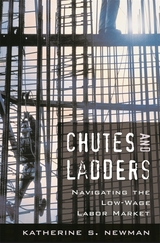 Chutes and Ladders: Navigating the Low-Wage Labor Market
Katherine S. Newman
Harvard University Press, 2006 Now that the welfare system has been largely dismantled, the fate of America's poor depends on what happens to them in the low-wage labor market. In this timely volume, Katherine S. Newman explores whether the poorest workers and families benefited from the tight labor markets and good economic times of the late 1990s. Following black and Latino workers in Harlem, who began their work lives flipping burgers, she finds more good news than we might have expected coming out of a high-poverty neighborhood. Many adult workers returned to school and obtained trade certificates, high school diplomas, and college degrees. Their persistence paid off in the form of better jobs, higher pay, and greater self-respect. Others found union jobs and, as a result, brought home bigger paychecks, health insurance, and a pension. More than 20 percent of those profiled in Chutes and Ladders are no longer poor.
A very different story emerges among those who floundered even in a good economy. Weighed down by family obligations or troubled partners and hindered by poor training and prejudice, these "low riders" moved in and out of the labor market, on and off public assistance, and continued to depend upon the kindness of family and friends.
Supplementing finely drawn ethnographic portraits, Newman examines the national picture to show that patterns around the country paralleled the findings from some of New York's most depressed neighborhoods. More than a story of the shifting fortunes of the labor market, Chutes and Ladders asks probing questions about the motivations of low-wage workers, the dreams they have for the future, and their understanding of the rules of the game.
CI vol 39 num 2
The University of Chicago Press
University of Chicago Press Journals, 2013
CI vol 39 num 3
The University of Chicago Press
University of Chicago Press Journals, 2013
CI vol 39 num 4
The University of Chicago Press
University of Chicago Press Journals, 2013
CI vol 40 num 1
The University of Chicago Press
University of Chicago Press Journals, 2013
CI vol 40 num 2
The University of Chicago Press
University of Chicago Press Journals, 2014
CI vol 40 num 3
The University of Chicago Press
University of Chicago Press Journals, 2014
CI vol 40 num 4
The University of Chicago Press
University of Chicago Press Journals, 2014
CI vol 41 num 1
The University of Chicago Press
University of Chicago Press Journals, 2014
CI vol 41 num 2
The University of Chicago Press
University of Chicago Press Journals, 2015
CI vol 41 num 3
The University of Chicago Press
University of Chicago Press Journals, 2015
CI vol 41 num 4
The University of Chicago Press
University of Chicago Press Journals, 2015
CI vol 42 num 1
The University of Chicago Press
University of Chicago Press Journals, 2015
CI vol 42 num 2
The University of Chicago Press
University of Chicago Press Journals, 2016
CI vol 42 num 3
The University of Chicago Press
University of Chicago Press Journals, 2016
CI vol 42 num 4
The University of Chicago Press
University of Chicago Press Journals, 2016
CI vol 43 num 1
The University of Chicago Press
University of Chicago Press Journals, 2016
CI vol 43 num 2
The University of Chicago Press
University of Chicago Press Journals, 2017
CI vol 43 num 3
The University of Chicago Press
University of Chicago Press Journals, 2017
CI vol 43 num 4
The University of Chicago Press
University of Chicago Press Journals, 2017
CI vol 44 num 1
The University of Chicago Press
University of Chicago Press Journals, 2017
CI vol 44 num 2
The University of Chicago Press
University of Chicago Press Journals, 2018
CI vol 44 num 3
The University of Chicago Press
University of Chicago Press Journals, 2018
CI vol 44 num 4
The University of Chicago Press
University of Chicago Press Journals, 2018
CI vol 45 num 1
The University of Chicago Press
University of Chicago Press Journals, 2018
CI vol 45 num 2
The University of Chicago Press
University of Chicago Press Journals, 2019
CI vol 45 num 3
The University of Chicago Press
University of Chicago Press Journals, 2019
CI vol 45 num 4
The University of Chicago Press
University of Chicago Press Journals, 2019
CI vol 46 num 1
The University of Chicago Press
University of Chicago Press Journals, 2019
CI vol 46 num 2
The University of Chicago Press
University of Chicago Press Journals, 2020
CI vol 46 num 3
The University of Chicago Press
University of Chicago Press Journals, 2020
CI vol 46 num 4
The University of Chicago Press
University of Chicago Press Journals, 2020
CI vol 47 num 1
The University of Chicago Press
University of Chicago Press Journals, 2020
CI vol 47 num 2
The University of Chicago Press
University of Chicago Press Journals, 2021
CI vol 47 num S2
The University of Chicago Press
University of Chicago Press Journals, 2021
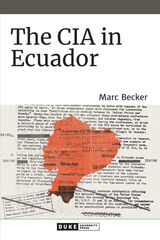 The CIA in Ecuador
Marc Becker
Duke University Press, 2021 In The CIA in Ecuador Marc Becker draws on recently released US government surveillance documents on the Ecuadorian left to chart social movement organizing efforts during the 1950s. Emphasizing the competing roles of the domestic ruling class and grassroots social movements, Becker details the struggles and difficulties that activists, organizers, and political parties confronted. He shows how leftist groups, including the Communist Party of Ecuador, navigated disagreements over tactics and ideology, and how these influenced shifting strategies in support of rural Indigenous communities and urban labor movements. He outlines the CIA's failure to understand that the Ecuadorian left was rooted in local social struggles rather than bankrolled by the Soviet Union. By decentering US-Soviet power struggles, Becker shows that the local patterns and dynamics that shaped the development of the Ecuadorian left could be found throughout Latin America during the cold war.
The CIA in Guatemala: The Foreign Policy of Intervention
By Richard H. Immerman
University of Texas Press, 1982 Using documents obtained through the Freedom of Information Act, recently opened archival collections, and interviews with the actual participants, Immerman provides us with a definitive, powerfully written, and tension-packed account of the United States' clandestine operations in Guatemala and their consequences in Latin America today.
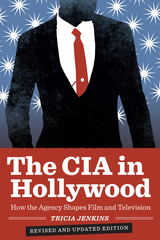 The CIA in Hollywood: How the Agency Shapes Film and Television
By Tricia Jenkins
University of Texas Press, 2016 What’s your impression of the CIA? A bumbling agency that can’t protect its own spies? A rogue organization prone to covert operations and assassinations? Or a dedicated public service that advances the interests of the United States? Astute TV and movie viewers may have noticed that the CIA’s image in popular media has spanned this entire range, with a decided shift to more positive portrayals in recent years. But what very few people know is that the Central Intelligence Agency has been actively engaged in shaping the content of film and television, especially since it established an entertainment industry liaison program in the mid-1990s. The CIA in Hollywood offers the first full-scale investigation of the relationship between the Agency and the film and television industries. Tricia Jenkins draws on numerous interviews with the CIA’s public affairs staff, operations officers, and historians, as well as with Hollywood technical consultants, producers, and screenwriters who have worked with the Agency, to uncover the nature of the CIA’s role in Hollywood. In particular, she delves into the Agency’s and its officers’ involvement in the production of The Agency, In the Company of Spies, Alias, The Recruit, The Sum of All Fears, Enemy of the State, Syriana, The Good Shepherd, and more. Her research reveals the significant influence that the CIA now wields in Hollywood and raises important and troubling questions about the ethics and legality of a government agency using popular media to manipulate its public image.
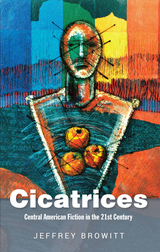 Cicatrices: Central American Fiction in the 21st Century
Jeffrey Browitt
Sussex Academic Press, 2022 Herein is a mix of male and female authors spread across five Central American countries: Guatemala, Nicaragua, El Salvador, Costa Rica and Honduras. Thematic unity is provided by nomadism, migration and the inability to leave behind a violent past of armed conflict that bleeds into the present—scars that won't heal. An atmosphere of survival, exhaustion, dissipation and decay (in both the physical and moral sense) dominates, but also rays of hope. This vibrant literature speaks of existential crisis in a context of social precarity and lack of opportunity as people dis-embedded by civil war and its aftermath seek release and fulfillment through migration across borders into neighboring countries or north to the United States or Europe. Whether external or internal, self-imposed or forced, migration brings the problem of mal-adaptation to new worlds and struggles with memoryan aesthetics of loss and solitude.
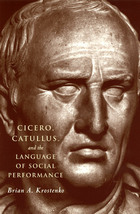 Cicero, Catullus, and the Language of Social Performance
Brian A. Krostenko
University of Chicago Press, 2001 Charm, wit, and style were critical, but dangerous, ingredients in the social repertoire of the Roman elite. Their use drew special attention, but also exposed one to potential ridicule or rejection for valuing style over substance. Brian A. Krostenko explores the complexities and ambiguities of charm, wit, and style in Roman literature of the late Republic by tracking the origins, development, and use of the terms that described them, which he calls "the language of social performance."
As Krostenko demonstrates, a key feature of this language is its capacity to express both approval and disdain—an artifact of its origins at a time when the "style" and "charm" of imported Greek cultural practices were greeted with both enthusiasm and hostility. Cicero played on that ambiguity, for example, by chastising lepidus ("fine") boys in the "Second Oration against Catiline" as degenerates, then arguing in his De Oratore that the successful speaker must have a certain charming lepos ("wit"). Catullus, in turn, exploited and inverted the political subtexts of this language for innovative poetic and erotic idioms.
Cicero on Oratory and Orators
Translated by J.S. Watson. Introduction by Ralph A. Micken. Foreword by David Potter. Preface by Richard Leo Enos
Southern Illinois University Press, 1986 Contains Cicero’s De Oratore and Brutus, influential sources over the centuries for ideas on rhetoric and training for public leadership. The De Oratore, written in 55 B.C., argues that rhetoric is socially significant because states are established and maintained through the leadership of eloquent men. The three books of dialogues in this volume feature discussions between well-known figures in Roman history, including Lucius Crassus, Marcus Antonius, Quintus Lutatius Catulus, Quintus Marcius Scaevola, Caius Aurelius Cotta, Julius Caesar Strabo Vopicus, and Publius Sulpicus Rufus. The Brutus continues the theme of the dialogues, giving a history of eminent orators whose performances exemplify the Ciceronian theory that rhetoric finally adds up to leadership.
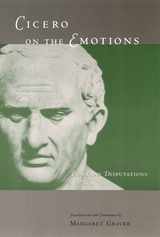 Cicero on the Emotions: Tusculan Disputations 3 and 4
Marcus Tullius Cicero
University of Chicago Press, 2002 The third and fourth books of Cicero's Tusculan Disputations deal with the nature and management of human emotion: first grief, then the emotions in general. In lively and accessible style, Cicero presents the insights of Greek philosophers on the subject, reporting the views of Epicureans and Peripatetics and giving a detailed account of the Stoic position, which he himself favors for its close reasoning and moral earnestness. Both the specialist and the general reader will be fascinated by the Stoics' analysis of the causes of grief, their classification of emotions by genus and species, their lists of oddly named character flaws, and by the philosophical debate that develops over the utility of anger in politics and war.
Margaret Graver's elegant and idiomatic translation makes Cicero's work accessible not just to classicists but to anyone interested in ancient philosophy and psychotherapy or in the philosophy of emotion. The accompanying commentary explains the philosophical concepts discussed in the text and supplies many helpful parallels from Greek sources.
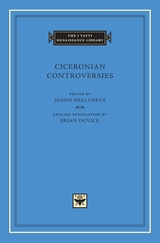 Ciceronian Controversies
Edited by JoAnn DellaNevaEnglish translation by Brian Duvick
Harvard University Press, 2007 The most important literary dispute of the Renaissance pitted those writers of Neo-Latin who favored imitation of Cicero alone, as the single best exemplar of Latin prose, against those who preferred to follow an eclectic array of literary models. This Ciceronian controversy is the subject of the texts collected for the first time in this volume: exchanges of letters between Angelo Poliziano and Paolo Cortesi; between Gianfrancesco Pico della Mirandola and Pietro Bembo; and between Giovambattista Giraldi Cinzio and his mentor Celio Calcagnini. A postscript by Lilio Gregorio Giraldi and writings by Antonio Possevino comment further on this correspondence.
Because they address some of the most fundamental aspects of literary production, these quarrels shed light on similar debates about vernacular literature, which also turned on imitation and the role of the author. The Ciceronian controversy can also be seen as part of larger cultural movements, such as the choice of vernacular language over Latin, the development of Jesuit pedagogy, and the religious conflicts that characterized much of the Renaissance.
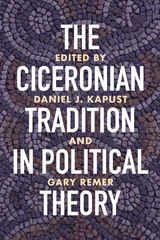 The Ciceronian Tradition in Political Theory
Edited by Daniel J. Kapust and Gary Remer
University of Wisconsin Press, 2021 Cicero is one of the most influential thinkers in the history of Western political thought, and interest in his work has been undergoing a renaissance in recent years. The Ciceronian Tradition in Political Theory focuses entirely on Cicero’s influence and reception in the realm of political thought.
Individual chapters examine the ways thinkers throughout history, specifically Augustine, John of Salisbury, Thomas More, Machiavelli, Montaigne, Hobbes, Locke, Adam Smith, and Edmund Burke, have engaged with and been influenced by Cicero. A final chapter surveys the impact of Cicero’s ideas on political thought in the second half of the twentieth century. By tracing the long reception of these ideas, the collection demonstrates not only Cicero’s importance to both medieval and modern political theorists but also the comprehensive breadth and applicability of his philosophy.
 Cicero's Practical Philosophy
Walter Nicgorski
University of Notre Dame Press, 2012
Cicero’s Practical Philosophy marks a revival over the last two generations of serious scholarly interest in Cicero’s political thought. Its nine original essays by a multidisciplinary group of distinguished international scholars manifest close study of Cicero’s philosophical writings and great appreciation for him as a creative thinker, one from whom we can continue to learn. This collection focuses initially on Cicero’s major work of political theory, his De Re Publica, and the key moral virtues that shape his ethics, but the contributors attend to all of Cicero’s primary writings on political community, law, the ultimate good, and moral duties. Room is also made for Cicero’s extensive writings on the art of rhetoric, which he explicitly draws into the orbit of his philosophical writings. Cicero’s concern with the divine, with epistemological issues, and with competing analyses of the human soul are among the matters necessarily encountered in pursuing, with Cicero, the large questions of moral and political philosophy, namely, what is the good and genuinely happy life and how are our communities to be rightly ordered.
The volume also reprints Walter Nicgorski’s classic essay “Cicero and the Rebirth of Political Philosophy,” which helped spark the current revival of interest in Cicero the philosopher.
“This well-planned and exceptionally well-written collection of articles brings together leading Cicero scholars of our day on a carefully chosen set of topics. As such, this book is an invaluable account of the current state of Cicero studies, while advancing those studies.” —Gerard Wegemer, University of Dallas
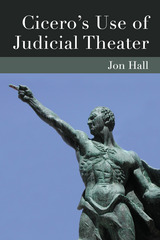 Cicero's Use of Judicial Theater
Jon Hall
University of Michigan Press, 2014 In Cicero’s Use of Judicial Theater, Jon Hall examines Cicero's use of showmanship in the Roman courts, looking in particular at the nonverbal devices that he employs during his speeches as he attempts to manipulate opinion. Cicero's speeches in the law-courts often incorporate theatrical devices including the use of family relatives as props during emotional appeals, exploitation of tears and supplication, and the wearing of specially dirtied attire by defendants during a trial, all of which contrast strikingly with the practices of the modem advocate. Hall investigates how Cicero successfully deployed these techniques and why they played such a prominent part in the Roman courts. These "judicial theatrics" are rarely discussed by the ancient rhetorical handbooks, and Cicero’s Use of Judicial Theater argues that their successful use by Roman orators derives largely from the inherent theatricality of aristocratic life in ancient Rome—most of the devices deployed in the courts appear elsewhere in the social and political activities of the elite. While Cicero’s Use of Judicial Theater will be of interest primarily to professional scholars and students studying the speeches of Cicero, its wider analyses, both of Roman cultural customs and the idiosyncratic practices of the courts, will prove relevant also to social historians, as well as historians of legal procedure.
 Cien años de identidad: Introducción a la literatura latinoamericana del siglo XX
Kelly Comfort
Georgetown University Press, 2018 Cien años de identidad: Introducción a la literatura latinoamericana del siglo XX [One Hundred Years of Identity: Introduction to Twentieth-Century Latin American Literature] is an advanced Spanish textbook and Latin American literature anthology, guiding students through the critical analysis of fourteen literary and filmic texts published between 1889 and 1995, including works from Jorge Luis Borges, Isabel Allende, and Gabriel García Márquez that represent some of the seminal works of Latin America. The textbook is designed to introduce students to the richness of twentieth-century Latin American literature and culture while building their skills in textual analysis through an examination of the theme of identity. The featured texts examine the complex and multifaceted topic of identity as the authors and protagonists struggle to understand themselves, determine their relationship to the world and others, and give meaning and significance to their existence. The textbook guides students step-by-step through critical analysis by presenting a range of tools and progressing from simple to more complex exercises and activities throughout the book. It is divided into four units based on various types of identity formation: (1) racial, ethnic, gender, and class identity; (2) existential(ist) identity; (3) temporal and spatial identity; (4) political and sexual identity. Serving as both a Latin American literature anthology and an upper-level Spanish textbook, Cien años de identidad aims to hone reading and interpretive strategies while also improving Spanish vocabulary and comprehension, oral and written communication, and cultural competency. Features: •Complete unabridged works from the following authors: Isabel Allende, Jorge Luis Borges, Rosario Castellanos, Julio Cortázar, Rubén Darío, Carlos Fuentes, Gabriel García Márquez, José Martí, Judith Ortiz Cofer, and Sergio Vodanovic
•Complete pedagogy included for the novel El beso de la mujer araña by Manuel Puig and the film Fresa y chocolate by Tomás Gutiérrez Alea and Juan Carlos Tabío, although these two works are not anthologized in the textbook
•Additional cultural contexts and author biographies for each text, as well as appropriate glosses and numbered lines for easy reference in class discussions
•Four end-of-unit chapters focused on comparative literature strategies that are designed to coach students on how to compare authors and texts across common themes and further improve critical analysis strategies
•Seventeen post-reading quizzes or homework assignments as well as a final examination, available to instructors only through the publisher's website
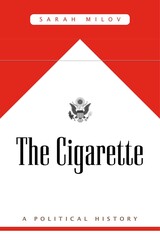 The Cigarette: A Political History
Sarah Milov
Harvard University Press, 2019 Los Angeles Times Book Prize Finalist
Winner of the Willie Lee Rose Prize
Winner of the PROSE Award in United States History
Hagley Prize in Business History Finalist
A Smithsonian Best History Book of the Year
“Vaping gets all the attention now, but Milov’s thorough study reminds us that smoking has always intersected with the government, for better or worse.”
—New York Times Book Review
From Jamestown to the Marlboro Man, tobacco has powered America’s economy and shaped some of its most enduring myths. The story of tobacco’s rise and fall may seem simple enough—a tale of science triumphing over corporate greed—but the truth is more complicated.
After the Great Depression, government officials and tobacco farmers worked hand in hand to ensure that regulation was used to promote tobacco rather than protect consumers. As evidence of the connection between cigarettes and cancer grew, scientists struggled to secure federal regulation in the name of public health. What turned the tide, Sarah Milov reveals, was a new kind of politics: a movement for nonsmokers’ rights. Activists took to the courts, the streets, city councils, and boardrooms to argue for smoke-free workplaces and allied with scientists to lobby elected officials. The Cigarette puts politics back at the heart of tobacco’s rise and fall, dramatizing the battles over corporate influence, individual choice, government regulation, and science.
“A nuanced and ultimately devastating indictment of government complicity with the worst excesses of American capitalism.”
—New Republic
“An impressive work of scholarship evincing years of spadework…A well-told story.”
—Wall Street Journal
“If you want to know what the smoke-filled rooms of midcentury America were really like, this is the book to read.”
—Los Angeles Review of Books
Cigarettes Are Sublime
Richard Klein
Duke University Press, 1993 Cigarettes are bad for you; that is why they are so good. With its origins in the author’s urgent desire to stop smoking, Cigarettes Are Sublime offers a provocative look at the literary, philosophical, and cultural history of smoking. Richard Klein focuses on the dark beauty, negative pleasures, and exacting benefits attached to tobacco use and to cigarettes in particular. His appreciation of paradox and playful use of hyperbole lead the way on this aptly ambivalent romp through the cigarette in war, movies (the "Humphrey Bogart cigarette"), literature, poetry, and the reflections of Sartre to show that cigarettes are a mixed blessing, precisely sublime.
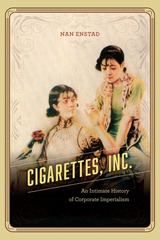 Cigarettes, Inc.: An Intimate History of Corporate Imperialism
Nan Enstad
University of Chicago Press, 2018 Traditional narratives of capitalist change often rely on the myth of the willful entrepreneur from the global North who transforms the economy and delivers modernity—for good or ill—to the rest of the world. With Cigarettes, Inc., Nan Enstad upends this story, revealing the myriad cross-cultural encounters that produced corporate life before World War II.
In this startling account of innovation and expansion, Enstad uncovers a corporate network rooted in Jim Crow segregation that stretched between the United States and China and beyond. Cigarettes, Inc. teems with a global cast—from Egyptian, American, and Chinese entrepreneurs to a multiracial set of farmers, merchants, factory workers, marketers, and even baseball players, jazz musicians, and sex workers. Through their stories, Cigarettes, Inc. accounts for the cigarette’s spectacular rise in popularity and in the process offers nothing less than a sweeping reinterpretation of corporate power itself.
Cilungu Phonology
Lee Bickmore
CSLI, 2007 Cilungu is an underrepresented language spoken in northern Zambia and Tanzania whose future is far from certain, given ongoing urbanization and the ascendancy of other regional languages. The product of over fifteen years of fieldwork, Cilungu Phonology presents a comprehensive description and analysis of this endangered language.
Featuring a reference grammar and formal analysis of Cilungu, this volume will be a major contribution to our understanding of tonology, since several of the forty-four processes analyzed appear to be unique to the language. It also includes a discussion of morphology, both nominal and verbal.
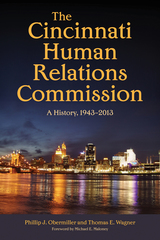 The Cincinnati Human Relations Commission: A History, 1943–2013
Phillip J. Obermiller
Ohio University Press, 2018 In the summer of 1943, as World War II raged overseas, the United States also faced internal strife. Earlier that year, Detroit had erupted in a series of race riots that killed dozens and destroyed entire neighborhoods. Across the country, mayors and city councils sought to defuse racial tensions and promote nonviolent solutions to social and economic injustices. In Cincinnati, the result of those efforts was the Mayor’s Friendly Relations Committee, later renamed the Cincinnati Human Relations Commission (CHRC). The Cincinnati Human Relations Commission: A History, 1943–2013, is a decade-by-decade chronicle of the agency: its accomplishments, challenges, and failures. The purpose of municipal human relations agencies like the CHRC was to give minority groups access to local government through internal advocacy, education, mediation, and persuasion—in clear contrast to the tactics of lawsuits, sit-ins, boycotts, and marches adopted by many external, nongovernmental organizations. In compiling this history, Phillip J. Obermiller and Thomas E. Wagner have drawn on an extensive base of archival records, reports, speeches, and media sources. In addition, archival and contemporary interviews provide first-person insight into the events and personalities that shaped the agency and the history of civil rights in this midwestern city.
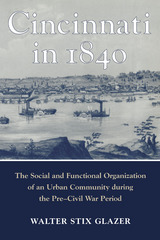 CINCINNATI IN 1840: The Social and Functional Organization of an Urban Community during the Pre-Civil War Period
WALTER STIX GLAZER
Ohio State University Press, 1999 During the pre-Civil War period, Cincinnati was the fastest growing and, according to many contemporary observers, most interesting city in America. This classic study, completed in the early 1970s, focuses on the community in 1840 to explain its success but also to suggest some broader patterns in the city’s development and American urbanization. Using local census records, city directories, tax lists, newspapers, and other contemporary sources, Walter Stix Glazer describes the demographic, social, economic, and political structure of the adult white male population in 1840 and then develops a unified model of its social and functional organizations. This analysis (based on computerized records of thousands of Cincinnatians) also documents some broader trends between 1820 and 1860: the volatility of Cincinnati’s labor force, the career patterns of its homeowners, and the leadership of a small group of successful citizens active in a broad range of voluntary associations. This statistical analysis is complemented with sections of traditional historical narrative and biographical profiles that illustrate the general themes of the book. Glazer argues that Cincinnati’s success up to 1840 was due to a unified booster vision and a cohesive community elite that gradually broke down, as a result of ethnic and economic division, over the next twenty years. This story has broader implications in terms of the character of Jacksonian democracy and American urbanization.
Cinco Becknell
LEE MAYNARD
West Virginia University Press, 2015 Cinco Becknell is the story of a homeless man with no memory. Locked in the emptiness of his mind is a secret, a past, which will either keep him alive or get him killed. As Cinco staggers through a dangerous journey of rediscovery, he is hunted by psychopaths who want to kill him, and he has no idea why; he is shadowed by a woman who may keep him alive—or not; and he is finally helped by another woman who can bring back to him the light he looks for—if he can stay alive. But he is running out of time, and people around him are dying, always violently. Gradually, he begins to understand the true, brutal, nature of himself and of the darkness of his past. But it is a past, and a present, that he may never fully understand. This novel, based on generations of violent, local family history, is set in the underbelly of the pseudo-glitzy streets of Santa Fe, New Mexico.
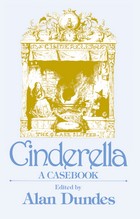 Cinderella: A Casebook
Alan Dundes
University of Wisconsin Press, 1988 Covering a period of more than one hundred years of work by renowned folklorists, these enlightening essays explore the timeless tale of Cinderella. In addition to the most famous versions of the story (Basile’s Pentamerone, Perrault’s Cendrillon, and the Grimm’s Aschenputtel), this casebook includes articles on other versions of the tale from Russian, English, Chinese, Greek and French folklore. The volume concludes with several interpretive essays, including a psychoanalytic view from Dundes and a critique of the popularization of Cinderella in America.
“Folklorists, scholars of children’s literature, and feminists should appreciate particularly the wide scope of this collection . . . now in paperback with an updated Bibliographical Addendum. . . . Most helpful are the two-page introductions to each variant and to each essay which include a brief overview of the historical times as well as suggested additional sources for more discussion.”—Danny Rochman, Folklore Forum
“A milestone, a near complete source of primary and secondary materials. . . . The selected analytical writing include definitive classic and new discoveries, covering the whole range of methodological modes and theoretical perspectives from early forms and typology to myth-ritual, social-historical, anthropological, and psychoanalytical readings. The annotated bibliography is most helpful, illuminating, and comprehensive, encompassing publications in other Western languages and works by Asianists.”—Chieko Mulhern, Asian Folklore Studies
“One can imagine several dimensions on which psychoanalysts might find such a collection interesting: as examples of applied psychoanalysis, in relation to philosophical and cultural examination of imaginative material, in relation to child development, and in the correlations between folktales of a particular culture and individual histories.”—Kerry Kelly Novick, Psychoanalytic Quarterly
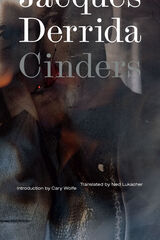 Cinders
Jacques Derrida
University of Minnesota Press, 2014 “More than fifteen years ago,” Jacques Derrida writes in the prologue to this remarkable and uniquely revealing book, “a phrase came to me, as though in spite of me. . . . It imposed itself upon me with the authority, so discreet and simple it was, of a judgment: ‘cinders there are’ (il y a là cendre). . . . I had to explain myself to it, respond to it—or for it.” In Cinders Derrida ranges across his work from the previous twenty years and discerns a recurrent cluster of arguments and images, all involving in one way or another ashes and cinders. For Derrida, cinders or ashes—at once fragile and resilient—are “the better paradigm for what I call the trace—something that erases itself totally, radically, while presenting itself.” In a style that is both highly condensed and elliptical, Cinders offers probing reflections on the relation of language to truth, writing, the voice, and the complex connections between the living and the dead. It also contains some of his most essential elaborations of his thinking on the feminine and on the legacy of the Holocaust (both a word—from the Greek hólos, “whole,” and kaustós, “burnt”—and a historical event that invokes ashes) in contemporary poetry and philosophy. In turning from the texts of other philosophers to his own, Cinders enables readers to follow the trajectory from Derrida’s early work on the trace, the gramma, and the voice to his later writings on life, death, time, and the spectral. Among the most accessible of this renowned philosopher’s many writings, Cinders is an evocative and haunting work of poetic self-analysis that deepens our understanding of Derrida’s critical and philosophical vision.
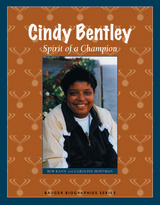 Cindy Bentley: Spirit of a Champion
Bob Kann
Wisconsin Historical Society Press, 2010 Cindy Bentley: Spirit of a Champion celebrates the life of one of Wisconsin's most inspirational leaders and activists. Born with an intellectual disability as the result of fetal alcohol syndrome, Cindy Bentley spent much of her childhood at the Southern Wisconsin Center for the Developmentally Disabled. No one expected her to learn the skills necessary to live on her own. To everyone's surprise, including her own, she did that and much more. With the encouragement of a teacher at Southern Center, Cindy realized she had a deep passion for sports, and the discipline to train and compete. She began participating in Special Olympics, and gained confidence as she worked with teammates to earn medals in tennis, track and field, and even snowshoeing. Chosen as a Global Messenger for the Special Olympics International in 2000, Cindy has had dinner at the White House with two different American presidents, traveled around the world, and given speeches in front of thousands of people. In these pages, young readers will learn what gives Cindy her champion spirit, and why she gave away some of her gold medals. Today, Cindy is still competing in Special Olympics. She also continues to advocate for people with disabilities, and helped to start People First, a statewide organization that encourages those with disabilities to speak up for their rights.
 Cindy Sherman's Office Killer: Another Kind of Monster
Dahlia Schweitzer
Intellect Books, 2014 One of the twentieth century’s most significant artists, Cindy Sherman has quietly uprooted conventional understandings of portraiture and art, questioning everything from identity to feminism. Critics around the world have taken Sherman’s photographs and extensively examined what lies underneath. However, little critical ink has been spilled on Sherman’s only film, Office Killer, a piece that plays a significant role both in Sherman’s body of work and in American art in the late twentieth century. Dahlia Schweitzer breaks the silence with her trenchant analysis of Office Killer and explores the film on a variety of levels, combating head-on the art world’s reluctance to discuss the movie and arguing instead that it is only through a close reading of the film that we can begin to appreciate the messages underlying all of Sherman’s work.
The first book on this neglected piece of an esteemed artist’s oeuvre, Cindy Sherman’s “Office Killer” rescues the film from critical oblivion and situates it next to the artist’s other iconic works.
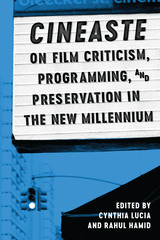 Cineaste on Film Criticism, Programming, and Preservation in the New Millennium
Edited by Cynthia Lucia and Rahul Hamid
University of Texas Press, 2017 Digital technology and the Internet have revolutionized film criticism, programming, and preservation in deeply paradoxical ways. The Internet allows almost everyone to participate in critical discourse, but many print publications and salaried positions for professional film critics have been eliminated. Digital technologies have broadened access to filmmaking capabilities, as well as making thousands of older films available on DVD and electronically. At the same time, however, fewer older films can be viewed in their original celluloid format, and newer, digitally produced films that have no “material” prototype are threatened by ever-changing servers that render them obsolete and inaccessible. Cineaste, one of the oldest and most influential publications focusing on film, has investigated these trends through a series of symposia with the top film critics, programmers, and preservationists in the United States and beyond. This volume compiles several of these symposia: “Film Criticism in America Today” (2000), “International Film Criticism Today” (2005), “Film Criticism in the Age of the Internet” (2008), “Film Criticism: The Next Generation” (2013), “The Art of Repertory Film Exhibition and Digital Age Challenges” (2010), and “Film Preservation in the Digital Age” (2011). It also includes interviews with the late, celebrated New Yorker film critic Pauline Kael and the critic John Bloom (“Joe Bob Briggs”), as well as interviews with the programmers/curators Peter von Bagh and Mark Cousins and with the film preservationist George Feltenstein. This authoritative collection of primary-source documents will be essential reading for scholars, students, and film enthusiasts.
Cine-Dispositives: Essays in Epistemology Across Media
Edited by François Albera and Maria Tortajada
Amsterdam University Press, 2015 This collection brings together a number of leading scholars in film studies to explore viewing and listening dispositives - the Foucauldian concept of a strategic and technical configuration of practices and discourses - from the emergence of film studies as a field in the 1960s to more recent uses of the concept. In particular, the contributors confront points of view and perspectives in the context of the rise and spread of new technologies, changes that are continually altering the boundaries and the spaces of cinema and thus demand new analysis and theoretization.
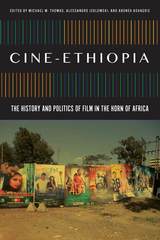 Cine-Ethiopia: The History and Politics of Film in the Horn of Africa
Michael W. Thomas
Michigan State University Press, 2018 Over the past decade, Ethiopian films have come to dominate the screening schedules of the many cinemas in Ethiopia’s capital city of Addis Ababa, as well as other urban centers. Despite undergoing an unprecedented surge in production and popularity in Ethiopia and in the diaspora, this phenomenon has been broadly overlooked by African film and media scholars and Ethiopianists alike. This collection of essays and interviews on cinema in Ethiopia represents the first work of its kind and establishes a broad foundation for furthering research on this topic. Taking an interdisciplinary approach to the topic and bringing together contributions from both Ethiopian and international scholars, the collection offers new and alternative narratives for the development of screen media in Africa. The book’s relevance reaches far beyond its specific locale of Ethiopia as contributions focus on a broad range of topics—such as commercial and genre films, diaspora filmmaking, and the role of women in the film industry—while simultaneously discussing multiple forms of screen media, from satellite TV to “video films.” Bringing both historical and contemporary moments of cinema in Ethiopia into the critical frame offers alternative considerations for the already radically changing critical paradigm surrounding the understandings of African cinema.
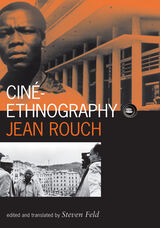 Cine-Ethnography
Jean Rouch
University of Minnesota Press, 2003 One of the most influential figures in documentary and ethnographic filmmaking, Jean Rouch has made more than one hundred films in West Africa and France. In such acclaimed works as Jaguar, The Lion Hunters, and Cocorico, Monsieur Poulet, Rouch has explored racism, colonialism, African modernity, religious ritual, and music. He pioneered numerous film techniques and technologies, and in the process inspired generations of filmmakers, from New Wave directors, who emulated his cinema verité style, to today’s documentarians.Ciné-Ethnography is a long-overdue English-language resource that collects Rouch's key writings, interviews, and other materials that distill his thinking on filmmaking, ethnography, and his own career. Editor Steven Feld opens with a concise overview of Rouch’s career, highlighting the themes found throughout his work. In the four essays that follow, Rouch discusses the ethnographic film as a genre, the history of African cinema, his experiences of filmmaking among the Songhay, and the intertwined histories of French colonialism, anthropology, and cinema. And in four interviews, Rouch thoughtfully reflects on each of his films, as well as his artistic, intellectual, and political concerns. Ciné-Ethnography also contains an annotated transcript of Chronicle of a Summer—one of Rouch's most important works—along with commentary by the filmmakers, and concludes with a complete, annotated filmography and a bibliography. The most thorough resource on Rouch available in any language, Ciné-Ethnography makes clear this remarkable and still vital filmmaker's major role in the history of documentary cinema. Jean Rouch was born in Paris in 1917. He studied civil engineering before turning to film and anthropology in response to his experiences in West Africa during World War II. Rouch is the recipient of numerous awards, including the International Critics Award at Cannes for the film Chronicle of a Summer in 1961. Steven Feld is professor of music and anthropology at Columbia University.
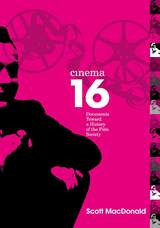 Cinema 16: Documents Toward History Of Film Society
Scott MacDonald
Temple University Press, 2002 As the most successful and influential film society in American history, Cinema 16 was a crucial organization for the creation of a public space for the full range of cinema achievement in the years following World War II. A precursor of the New York Film Festival, Cinema 16 screenings became a gathering place for New Yorkers interested not only in cinema, but in the use of media in the development of a more complete, effective democracy. For seventeen years, many of the leading intellectuals and artists of the time came together as part of a membership society of thousands to experience the creative programming of Cinema 16 director, Amos Vogel. What audiences saw at Cinema 16 changed their lives and had an enduring impact not only on the New York City cultural scene, but nationwide. Vogel's distribution of landmark documentary and avant-garde films helped make a place for many films that could never have had commercial release, given the pressures of commercialism and censorship during the postwar era.
Vogel's commitment to the broadest range of cinema practice led him to develop a programming strategy, inherited from the European cine-club movement, that involved confronting audiences with such a wide range of cinematic forms that viewers left the theater considering not only the often remarkable films Vogel showed, but the place of Cinema itself in modern life.
Cinema 16: Documents Toward a History of the Film Society is the first book on Cinema 16. Scott MacDonald provides a sense of the life and work of the society, using the complete Cinema 16 program announcements, selected letters between Vogel and the filmmakers whose films he showed; selections from the program notes that accompanied Cinema 16 screenings, theoretical essays by Vogel on curating independent cinema; conversations between MacDonald and Cinema 16 members; photographs and stills; and a variety of other documents.
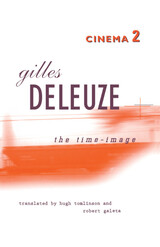 Cinema 2: The Time-Image
Gilles Deleuze
University of Minnesota Press, 1989 Cinema 2: The Time-Image brings to completion Gilles Deleuze’s work on the theoretical implications of the cinematographic image. In Cinema 1: The Movement-Image, Deleuze proposed a new way to understand narrative cinema, based on Henri Bergson’s notion of the movement-image and C. S. Peirce’s classification of images and signs. In Cinema 2, he explains why, since World War II, time has come to dominate film: the fragment or solitary image, in supplanting narrative cinema’s rational development of events, illustrates this new significance of time. Deleuze ascribes this shift to the condition of postwar Europe: the situations and spaces “we no longer know how to describe”—buildings deserted but inhabited, cities undergoing demolition or reconstruction—and the new race of characters who emerged from this rubble, mutants, who “saw rather than acted.” Deleuze discusses the films of Rossellini, De Sica, Fellini, Godard, Resnais, Antonioni, Pasolini, Rohmer, Ophuls, and many others, suggesting that contemporary cinema, far from being dead, is only beginning to find new ways to capture time in the image.
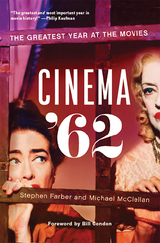 Cinema '62: The Greatest Year at the Movies
Stephen Farber
Rutgers University Press, 2024 Lawrence of Arabia, The Miracle Worker, To Kill a Mockingbird, The Manchurian Candidate, Gypsy, Sweet Bird of Youth, The Longest Day, The Music Man, What Ever Happened to Baby Jane, and more. Most conventional film histories dismiss the early 1960s as a pallid era, a downtime between the heights of the classic studio system and the rise of New Hollywood directors like Scorsese and Altman in the 1970s. It seemed to be a moment when the movie industry was floundering as the popularity of television caused a downturn in cinema attendance. Cinema ’62 challenges these assumptions by making the bold claim that 1962 was a peak year for film, with a high standard of quality that has not been equaled since.
Stephen Farber and Michael McClellan show how 1962 saw great late-period work by classic Hollywood directors like John Ford, Howard Hawks, and John Huston, as well as stars like Bette Davis, James Stewart, Katharine Hepburn, and Barbara Stanwyck. Yet it was also a seminal year for talented young directors like Sidney Lumet, Sam Peckinpah, and Stanley Kubrick, not to mention rising stars like Warren Beatty, Jane Fonda, Robert Redford, Peter O’Toole, and Omar Sharif. Above all, 1962—the year of To Kill a Mockingbird and The Manchurian Candidate—gave cinema attendees the kinds of adult, artistic, and uncompromising visions they would never see on television, including classics from Fellini, Bergman, and Kurosawa. Culminating in an analysis of the year’s Best Picture winner and top-grossing film, Lawrence of Arabia, and the factors that made that magnificent epic possible, Cinema ’62 makes a strong case that the movies peaked in the Kennedy era.
Cinema Against Spectacle: Technique and Ideology Revisited
Jean-Louis Comolli
Amsterdam University Press, 2015 Jean-Louis Comolli’s six-part essay Technique and Ideologyhad a revolutionary effect on film theory and history when it first appeared in Cahiers du Cinéma in 1971. In 2009, Comolli revisited his earlier text, arguing that the present age, marked by the total dominance of media-filtered spectacle over image production, makes the need for an 'emancipated, critical spectator' more pressing than ever. In this volume, Daniel Fairfax presents annotated translations of these two texts to provide an overview of Comolli’s activity as both a theorist and a filmmaker.
Cinema and Landscape
Edited by Graeme Harper and Jonathan Rayner
Intellect Books, 2010 The notion of landscape is a complex one, but it has been central to the art and artistry of the cinema. After all, what is the French New Wave without Paris? What are the films of Sidney Lumet, Woody Allen, Martin Scorsese, and Spike Lee without New York? Cinema and Landscape frames contemporary film landscapes across the world, in an exploration of screen aesthetics and national ideology, film form and cultural geography, cinematic representation and the human environment. Written by well-known cinema scholars, this volume both extends the existing field of film studies and stakes claims to overlapping, contested territories in the humanities and social sciences.
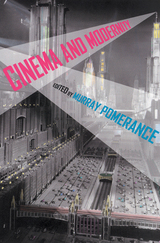 Cinema and Modernity
Pomerance, Murray
Rutgers University Press, 2006 The modern impulse gave us captivating technology and dark anxiety, rampant mobility and a world filled with strangers, the futuristic city and a fragmentation of experience. Motion pictures––the quintessence of modernism––entered into this cultural, technical, and philosophical richness with a vast public appeal and a jarring new vision of what life could be.
In Cinema and Modernity, Murray Pomerance brings together new essays by seventeen leading scholars to explore the complexity of the essential connection between film and modernity. Among the many films considered are Detour, Shock Corridor, The Last Laugh, Experiment in Terror, The Great Dictator, Leave Her to Heaven, The Talented Mr. Ripley, Eyes Wide Shut, Sunrise, The Crowd, The Shape of Things to Come, The War of the Worlds, The Day the Earth Stood Still, Scarlet Street, Shadow of a Doubt, Stella Dallas, The Blue Angel, Sullivan’s Travels, and Catch Me If You Can.
Cinema and Narrative Complexity: Embodying the Fabula
Steffen Hven
Amsterdam University Press, 2017 Since the mid-1990s, a number of films from international filmmakers have experimented with increasingly complicated narrative strategies-including such hits as Run, Lola, Run, 21 Grams, and Memento. This book sets those films and others in context with earlier works that tried new narrative approaches, including Stage Fright and Hiroshima, Mon Amour, to show how they reveal the limitations of most of our usual tools for analysing film. In light of that, Steffen Hven argues for the deployment of an 'embodied' reconfiguration of the cinematic experience, one that allows us to rethink such core constituents of narrative understanding as cognition, emotion, and affect.
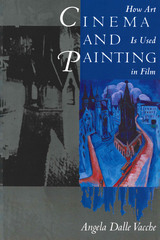 Cinema and Painting: How Art Is Used in Film
By Angela Dalle Vacche
University of Texas Press, 1996 The visual image is the common denominator of cinema and painting, and indeed many filmmakers have used the imagery of paintings to shape or enrich the meaning of their films. In this discerning new approach to cinema studies, Angela Dalle Vacche discusses how the use of pictorial sources in film enables eight filmmakers to comment on the interplay between the arts, on the dialectic of word and image, on the relationship between artistic creativity and sexual difference, and on the tension between tradition and modernity. Specifically, Dalle Vacche explores Jean-Luc Godard's iconophobia (Pierrot Le Fou) and Andrei Tarkovsky's iconophilia (Andrei Rubleov), Kenji Mizoguchi's split allegiances between East and West (Five Women around Utamaro), Michelangelo Antonioni's melodramatic sensibility (Red Desert), Eric Rohmer's project to convey interiority through images (The Marquise of O), F. W. Murnau's debt to Romantic landscape painting (Nosferatu), Vincente Minnelli's affinities with American Abstract Expressionism (An American in Paris), and Alain Cavalier's use of still life and the close-up to explore the realms of mysticism and femininity (Thérèse). While addressing issues of influence and intentionality, Dalle Vacche concludes that intertextuality is central to an appreciation of the dialogical nature of the filmic medium, which, in appropriating or rejecting art history, defines itself in relation to national traditions and broadly shared visual cultures.
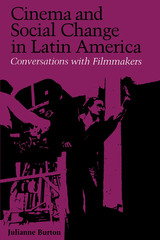 Cinema and Social Change in Latin America: Conversations with Filmmakers
Edited by Julianne Burton
University of Texas Press, 1986 Since the late 1960s, films from Latin America have won widening audiences in North America and Europe. Until now, no single book has offered an introduction to the diverse personalities and practices that make up this important regional film movement. In Cinema and Social Change in Latin America, Julianne Burton presents twenty interviews with key figures of Latin American cinema, covering three decades and ranging from Argentina to Mexico. Interviews with pioneers Fernando Birri, Nelson Pereira dos Santos, and Glauber Rocha, renowned feature filmmakers Tomás Gutiérrez Alea and Carlos Diegues, prize-winning documentarists Patricio Guzmán and Helena Solberg-Ladd, among others, endeavor to balance personal achievement against the backdrop of historical, political, social, and economic circumstances that have influenced each director's career. Presented also are conversations that cast light on the related activities of acting, distribution, theory, criticism, and film-based community organizing. More than their counterparts in other regions of the world, Latin American artists and intellectuals acknowledge the degree to which culture is shaped by history and politics. Since the mid-1950s, a period of rising nationalism and regional consciousness, talented young artists and activists have sought to redefine the uses of the film medium in the Latin American context. Questioning the studio and star systems of the Hollywood industrial model, these innovators have developed new forms, content, and processes of production, distribution, and reception. The specific approaches and priorities of the New Latin American Cinema are far from monolithic. They vary from realism to expressionism, from observational documentary to elaborate fictional constructs, from "imperfect cinema" to a cinema that emulates the high production values of the developed sectors, from self-reflexive to "transparent" cinematic styles, from highly industrialized modes of production to purely artisanal ones. What does not vary is the commitment to film as a vehicle for social transformation and the expression of national and regional cultural autonomy. From early alternative cinema efforts in Argentina, Brazil, and Cuba to a contemporary perspective from within the Mexican commercial industry to the emerging cinema and video production from Central America, Cinema and Social Change in Latin America offers the most comprehensive look at Latin American film available today.
 Cinema and the Sandinistas: Filmmaking in Revolutionary Nicaragua
By Jonathan Buchsbaum
University of Texas Press, 2003 Following the Sandinista Revolution in 1979, young bohemian artists rushed to the newly formed Nicaraguan national film institute INCINE to contribute to "the recovery of national identity" through the creation of a national film project. Over the next eleven years, the filmmakers of INCINE produced over seventy films—documentary, fiction, and hybrids—that collectively reveal a unique vision of the Revolution drawn not from official FSLN directives, but from the filmmakers' own cinematic interpretations of the Revolution as they were living it. This book examines the INCINE film project and assesses its achievements in recovering a Nicaraguan national identity through the creation of a national cinema. Using a wealth of firsthand documentation—the films themselves, interviews with numerous INCINE personnel, and INCINE archival records—Jonathan Buchsbaum follows the evolution of INCINE's project and situates it within the larger historical project of militant, revolutionary filmmaking in Latin America. His research also raises crucial questions about the viability of national cinemas in the face of accelerating globalization and technological changes which reverberate far beyond Nicaragua's experiment in revolutionary filmmaking.
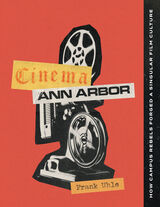 Cinema Ann Arbor: How Campus Rebels Forged a Singular Film Culture
Frank Uhle
University of Michigan Press, 2023 Ann Arbor, long known for its political and cultural activism, has an equally compelling history of engagement with film and media. In their quest to show art and independent films and in their efforts to raise money in the name of artistic freedom, local and campus societies pushed the boundaries of conformity. Delving into almost one hundred years of rarely glimpsed history, Cinema Ann Arbor melds interviews, deep archival research, and over four hundred images into a vivid history of film in one extraordinary town. These stories, told with urgency and exquisite detail, are firsthand accounts of the unforgettable people who created Ann Arbor’s magnificent twentieth-century film scene. Featuring interviews with filmmaker Ken Burns, Oscar-nominated editor Jay Cassidy, producer John Sloss, and more, this masterpiece provides insights into how a Midwestern college town developed a robust underground art film community that inspired those across the country. Variety’s Owen Glieberman says, “Frank Uhle has captured the moment when cinema became, for a new generation, a kind of religion, with its own rituals and sacred texts and a spirit of exploratory mystery that has all but vanished from the culture.” This is a must-have book for cinema and media aficionados, film archivists, and anyone interested in the cultural history of Ann Arbor. This book was published in collaboration with Fifth Avenue Press at Ann Arbor District Library. Learn more about their publishing program here. You can also see their collection, including vintage flyers, photos, film schedules, here.
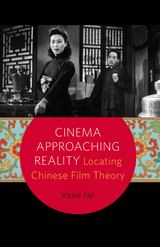 Cinema Approaching Reality: Locating Chinese Film Theory
Victor Fan
University of Minnesota Press, 2015 In Cinema Approaching Reality, Victor Fan brings together, for the first time, Chinese and Euro-American film theories and theorists to engage in critical debates about film in Shanghai and Hong Kong from the 1920s through 1940s. His point of departure is a term popularly employed by Chinese film critics during this period, bizhen, often translated as “lifelike” but best understood as “approaching reality.” What these Chinese theorists mean, in Fan’s reading, is that the cinematographic image is not a form of total reality, but it can allow spectators to apprehend an effect as though they had been there at the time when an event actually happened. Fan suggests that the phrase “approaching reality” can help to renegotiate an aporia (blind spot) that influential French film critic André Bazin wrestled with: the cinematographic image is a trace of reality, yet reality is absent in the cinematographic image, and the cinema makes present this absence as it reactivates the passage of time. Fan enriches Bazinian cinematic ontology with discussions on cinematic reality in Republican China and colonial Hong Kong, putting Western theorists—from Bazin and Kracauer to Baudrillard, Agamben, and Deleuze—into dialogue with their Chinese counterparts. The result is an eye-opening exploration of the potentialities in approaching cinema anew, especially in the photographic materiality following its digital turn.
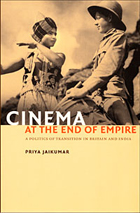 Cinema at the End of Empire: A Politics of Transition in Britain and India
Priya Jaikumar
Duke University Press, 2006 How did the imperial logic underlying British and Indian film policy change with the British Empire’s loss of moral authority and political cohesion? Were British and Indian films of the 1930s and 1940s responsive to and responsible for such shifts? Cinema at the End of Empire illuminates this intertwined history of British and Indian cinema in the late colonial period. Challenging the rubric of national cinemas that dominates film studies, Priya Jaikumar contends that film aesthetics and film regulations were linked expressions of radical political transformations in a declining British empire and a nascent Indian nation. As she demonstrates, efforts to entice colonial film markets shaped Britain’s national film policies, and Indian responses to these initiatives altered the limits of colonial power in India. Imperially themed British films and Indian films envisioning a new civil society emerged during political negotiations that redefined the role of the state in relation to both film industries. In addition to close readings of British and Indian films of the late colonial era, Jaikumar draws on a wealth of historical and archival material, including parliamentary proceedings, state-sponsored investigations into colonial filmmaking, trade journals, and intra- and intergovernmental memos regarding cinema. Her wide-ranging interpretations of British film policies, British initiatives in colonial film markets, and genres such as the Indian mythological film and the British empire melodrama reveal how popular film styles and controversial film regulations in these politically linked territories reconfigured imperial relations. With its innovative examination of the colonial film archive, this richly illustrated book presents a new way to track historical change through cinema.
 Cinema Babel: Translating Global Cinema
Abe Mark Nornes
University of Minnesota Press, 2007 The original foreign film—its sights and sounds—is available to all, but the viewer is utterly dependent on a translator and an untold number of technicians who produce the graphic text or disconnected speech through which we must approach the foreign film. A bad translation can ruin a film’s beauty, muddy its plot, and turn any joke sour. In this wide-ranging work, Abé Mark Nornes examines the relationships between moving-image media and translation and contends that film was a globalized medium from its beginning and that its transnational traffic has been greatly influenced by interpreters. He discusses the translation of film theory, interpretation at festivals and for coproductions, silent era practice, “ talkies,” subtitling, and dubbing. Nornes—who has written subtitles for Japanese cinema—looks at the ways misprision of theory translations produced stylistic change, how silent era lecturers contributed to the construction of national cinemas, how subtitlers can learn from anime fans, and how ultimately interpreters can be, in his terms, “traders or traitors.” Abé Mark Nornes is associate professor of Asian languages and cultures and film and video studies at the University of Michigan. He is the author of Japanese Documentary Film (Minnesota, 2003) and Forest of Pressure (Minnesota, 2007).
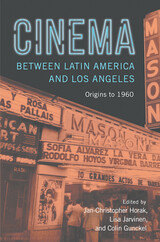 Cinema between Latin America and Los Angeles: Origins to 1960
Horak, Jan-Christopher
Rutgers University Press, 2019 Historically, Los Angeles and its exhibition market have been central to the international success of Latin American cinema. Not only was Los Angeles a site crucial for exhibition of these films, but it became the most important hub in the western hemisphere for the distribution of Spanish language films made for Latin American audiences. Cinema between Latin America and Los Angeles builds upon this foundational insight to both examine the considerable, ongoing role that Los Angeles played in the history of Spanish-language cinema and to explore the implications of this transnational dynamic for the study and analysis of Latin American cinema before 1960. The volume editors aim to flesh out the gaps between Hollywood and Latin America, American imperialism and Latin American nationalism in order to produce a more nuanced view of transnational cultural relations in the western hemisphere.
Cinema Beyond Film: Media Epistemology in the Modern Era
Edited by François Albera and Maria Tortajada
Amsterdam University Press, 2010
Cinema Beyond Film elaborates on the theoretical uses of two key terms—dispositif and episteme—in order to examine their relationship as well as their larger connections to film, technology, and modernity. Although both terms originate in the work of Foucault, dispositif (“device”) intrinsically links itself to the mechanics of movement and speed behind cinematics, while more generally referring to the mechanisms and structures that hold power in place. Episteme(“to know”), on the other hand, refers to the conditions and possibilities of knowledge and reception, more than to technological innovation. Each term is explored here in relation to the other, allowing this edited collection to assess the wide array of potential materialities that arise from the mechanics behind cinema and the changing face of its technology.
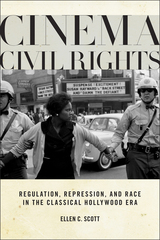 Cinema Civil Rights: Regulation, Repression, and Race in the Classical Hollywood Era
Scott, Ellen C
Rutgers University Press, 2015 From Al Jolson in blackface to Song of the South, there is a long history of racism in Hollywood film. Yet as early as the 1930s, movie studios carefully vetted their releases, removing racially offensive language like the “N-word.” This censorship did not stem from purely humanitarian concerns, but rather from worries about boycotts from civil rights groups and loss of revenue from African American filmgoers.
Cinema Civil Rights presents the untold history of how Black audiences, activists, and lobbyists influenced the representation of race in Hollywood in the decades before the 1960s civil rights era. Employing a nuanced analysis of power, Ellen C. Scott reveals how these representations were shaped by a complex set of negotiations between various individuals and organizations. Rather than simply recounting the perspective of film studios, she calls our attention to a variety of other influential institutions, from protest groups to state censorship boards.
Scott demonstrates not only how civil rights debates helped shaped the movies, but also how the movies themselves provided a vital public forum for addressing taboo subjects like interracial sexuality, segregation, and lynching. Emotionally gripping, theoretically sophisticated, and meticulously researched, Cinema Civil Rights presents us with an in-depth look at the film industry’s role in both articulating and censoring the national conversation on race.
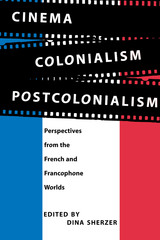 Cinema, Colonialism, Postcolonialism: Perspectives from the French and Francophone Worlds
Edited by Dina Sherzer
University of Texas Press, 1996 In this first major study of French colonial and postcolonial cinema, Dina Sherzer compiles essays by some of the foremost scholars on the subject who interrogate and analyze the realities behind the images of the nation's past and present. Through an examination of France and its colonies, multiethnic contemporary France, and cinematic discourses which have been and are being produced about France's colonial past, these authors explore how the images relay underlying assumptions and their relation to historical and political facts. A variety of subjects and viewpoints inform these studies, which cover the entire range of films on that topic. The authors expound upon the role French and Francophone films are currently playing in reconstructing and imagining France's colonial past. Not only do the essays examine how French cinema has represented the encounter of French citizens with individuals from former colonies during the colonial era; they examine how French cinema has portrayed and has come to terms with the immigration of former colonial subjects to France. In addition, the book features another postcolonial facet by analyzing films of directors from the former colonies who give their own representation of colonialism and presentation of their culture. This study is a major contribution to postcolonial research. Race, gender, and geography are central themes throughout this book that presents innovative material that contributes to the history of French cinema and emphasizes how cinema participates in and is a part of national culture.
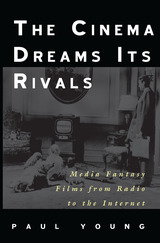 The Cinema Dreams Its Rivals: Media Fantasy Films from Radio to the Internet
Paul Young
University of Minnesota Press, 2006 By the middle of the twentieth century, Hollywood, formerly the one and only dream factory, found itself facing a host of media rivals for the public’s attention. In the 1980s, another competitor arrived in the form of the proto-Internet—a computer network as yet untested by all but research scientists, college students, the military, and a few thousand PC and modem owners. How did Hollywood respond to this nascent challenge? By dreaming about it, in a series of technological fantasies, from Tron to War Games to Lawnmower Man. The Cinema Dreams Its Rivals examines the meaning and effect of the movies’ attempts to reshape the shifting media landscape.
Paul Young looks at the American cinema’s imaginative constructions of three electronic media—radio, television, and the Internet—at the times when these media seemed to hold limitless possibilities. In doing so, he demonstrates that Hollywood is indelibly marked by the advent of each new medium, from the inclusion of sound in motion pictures to the use of digital graphics. But conversely, Young argues, the identities of the new media are themselves changed as Hollywood turns them to its own purposes and its own dreams.
Paul Young is professor of English and director of the film studies program at Vanderbilt University.
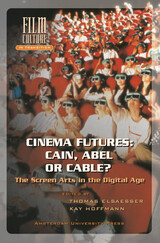 Cinema Futures: Cain, Abel or Cable?: The Screen Arts in the Digital Age
Edited by Kay Hoffmann
Amsterdam University Press, 1998 In the late 1960s, the cinema was pronounced dead. Television, like a Biblical Cain had slain his brother Abel. Some thirty years later, a remarkable reversal: rarely has the cinema been more popular. And yet, rarely has the cinema's future seemed more uncertain. Cinema Futures: Cain, Abel or Cable? presents a careful and forceful argument about predictions that tend to be made when new technologies appear. Examining the complex dynamics of convergence and divergence among the audio-visual media, the authors are realistic in their estimate of the future of the cinema's distinctive aesthetic identity, and robustly optimistic that the different social needs audiences bring to the public and domestic media will ensure their distinctiveness, as well as the necessary openness of cultural meaning and creative imput. The chief contributors include producers, historians, critics and journalists from several countries, creating a lively volume, rich in information and case studies, useful to media students and film scholars, as well as to anyone interested in better understanding the momentous changes transforming our worlds of sound and image.
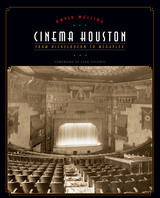 Cinema Houston: From Nickelodeon to Megaplex
By David Welling
University of Texas Press, 2007 Cinema Houston celebrates a vibrant century of movie theatres and moviegoing in Texas's largest city. Illustrated with more than two hundred historical photographs, newspaper clippings, and advertisements, it traces the history of Houston movie theatres from their early twentieth-century beginnings in vaudeville and nickelodeon houses to the opulent downtown theatres built in the 1920s (the Majestic, Metropolitan, Kirby, and Loew's State). It also captures the excitement of the neighborhood theatres of the 1930s and 1940s, including the Alabama, Tower, and River Oaks; the theatres of the 1950s and early 1960s, including the Windsor and its Cinerama roadshows; and the multicinemas and megaplexes that have come to dominate the movie scene since the late 1960s. While preserving the glories of Houston's lost movie palaces—only a few of these historic theatres still survive—Cinema Houston also vividly re-creates the moviegoing experience, chronicling midnight movie madness, summer nights at the drive-in, and, of course, all those tasty snacks at the concession stand. Sure to appeal to a wide audience, from movie fans to devotees of Houston's architectural history, Cinema Houston captures the bygone era of the city's movie houses, from the lowbrow to the sublime, the hi-tech sound of 70mm Dolby and THX to the crackle of a drive-in speaker on a cool spring evening.
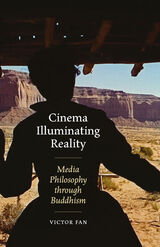 Cinema Illuminating Reality: Media Philosophy through Buddhism
Victor Fan
University of Minnesota Press, 2022 A new critical approach to cinema and media based on Buddhism as a philosophical discourse
How can a philosophical discourse generated in Asia help us reframe and renew cinema and media theory? Cinema Illuminating Reality provides a possible way to do this by using Buddhist ideas to examine the intricate relationship between technicity and consciousness in the cinema. The resulting dialogue between Buddhism and Euro-American philosophy is the first of its kind in film and media studies. Victor Fan examines cinema’s ontology and ontogenetic formation and how such a formational process produces knowledge, political agency, and in-aesthetics. Buddhism allows Fan to deconstruct binary thinking and reimagine media as an ecology, rethinking cinema in relational terms between the human and the machine. Along the way, Fan considers a wide variety of case studies from around the globe, while paying special attention to how contemporary Tibeto-Sinophone filmmakers have adopted relational thinking to detail ways of rebuilding a world that appears to be beyond repair. From Chinese queer cinema to a reexamination of Japanese master Ozu’s work and its historical reception to Christian Petzold’s 2018 existential thriller Transit, CinemaIlluminating Reality forges a remarkable path between Buddhist studies and cinema studies, casting vital new light on both of these important subjects.
 Cinema India: The Visual Culture of Hindi Film
Rachel Dwyer and Divia Patel
Rutgers University Press, 2002 As the largest producer of films in the world, Indian cinema is both a major industry and a distinctive art form that permeates daily life in that country and shapes emerging global cultures elsewhere. While much has been written on the history of Indian cinema, its iconography and aesthetics have yet to be analyzed as reflections of national and cultural identities. In this important new work, Rachel Dwyer and Divia Patel focus on the development of Bombay-based commercial cinema since 1913, exploring the symbolic role of settings and costumes in staging the nation and the function of makeup and hairstyles in defining notions of beauty, sexuality, and consumption. The authors also examine how factors such as ethnicity, modernization, and Westernization impact reception of film along caste, region, language, and religious lines.
The economic influence of advertising in actually determining film content and the dissemination of its imagery are also discussed. Film studies scholars recently have begun to investigate advertising in the film industry and this book makes an important contribution to this emerging subfield in its engagement with Indian cinema and the impact of advertising on the culture at large.
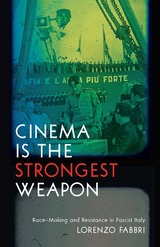 Cinema is the Strongest Weapon: Race-Making and Resistance in Fascist Italy
Lorenzo Fabbri
University of Minnesota Press, 2023 A deep dive into Italian cinema under Mussolini’s regime and the filmmakers who used it as a means of antifascist resistance
Looking at Italy’s national film industry under the rule of Benito Mussolini and in the era that followed, Cinema Is the Strongest Weapon examines how cinema was harnessed as a political tool by both the reigning fascist regime and those who sought to resist it. Covering a range of canonical works alongside many of their neglected contemporaries, this book explores film’s mutable relationship to the apparatuses of state power and racial capitalism. Exploiting realism’s aesthetic, experiential, and affective affordances, Mussolini’s biopolitical project employed cinema to advance an idealized vision of life under fascism and cultivate the basis for a homogenous racial identity. In this book, Lorenzo Fabbri crucially underscores realism’s susceptibility to manipulation from diametrically opposed political perspectives, highlighting the queer, Communist, Jewish, and feminist filmmakers who subverted Mussolini’s notion that “cinema is the regime’s strongest weapon” by developing film narratives and film forms that challenged the prevailing ethno-nationalist ideology. Focusing on an understudied era of film history and Italian cultural production, Fabbri issues an important recontextualization of Italy’s celebrated neorealist movement and the structural ties it shares with its predecessor. Drawing incisive parallels to contemporary debates around race, whiteness, authoritarianism, and politics, he presents an urgent examination into the broader impact of visual media on culture and society. Retail e-book files for this title are screen-reader friendly with images accompanied by short alt text and/or extended descriptions.
Cinema Judaica
Ken Sutak
Central Conference of American Rabbis, 2012 A unique look at how these Jewish-themed movies prepared Americans for war with Nazi Germany, rallied the Allies to victory, fought anti-Semitism, portrayed the Holocaust in Europe, and captured the refugee exodus to Israel. Featuring 200 rare movie posters, publicity stills, and other images in full-color. An ebook companion volume to the acclaimed exhibit.
The Cinema Makers: Public Life and the Exhibition of Difference in South-Eastern and Central Europe since the 1960s
Anna Schober
Intellect Books, 2013 The Cinema Makers investigates how cinema spectators in southeastern and central European cities became cinema makers through such practices as squatting in existing cinema spaces, organizing cinema "events," writing about film, and making films themselves. Drawing on a corpus of interviews with cinema activists in Germany, Austria, and the former Yugoslavia, Anna Schober compares the activities and artistic productions they staged in cities such as Vienna, Cologne, Munich, Berlin, Hamburg, Ljubljana, Belgrade, Novi Sad, Subotica, Zagreb, and Sarajevo. The resulting study illuminates the differences and similarities in the development of political culture—and cinema’s role in that development—in European countries with pluralist-democratic, one-party socialist, and post-socialist traditions.
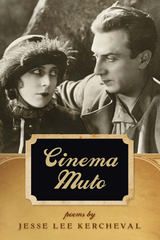 Cinema Muto
Jesse Lee Kercheval
Southern Illinois University Press, 2009 In Cinema Muto, Jesse Lee Kercheval examines the enduring themes of time, mortality, and love as revealed through the power of silent film. Following the ten days of the annual Le Giornate del Cinema Muto in Italy, this collection of ekphrastic poems are love letters to the evocative power of silent cinema. Kercheval’s poems elegantly capture the allure of these rare films, which compel hundreds of pilgrims from around the world—from scholars and archivists, to artists and connoisseurs—to flock to Italy each autumn. Cinema Muto celebrates the flickering tales of madness and adventure, drama and love, which are all too often left to decay within forgotten vaults. As reels of Mosjoukine and D. W. Griffith float throughout the collection, a portrait also emerges of the simple beauty of Italy in October and of two lovers who are drawn together by their mutual passion for an extinct art. Together they revel in recapturing “the black and white gestures of a lost world.” Cinema Muto is a tender tribute to the brief yet unforgettable reign of silent film. Brimming with stirring images of dreams, desire, and the ghosts of cinema legends gone by, Kercheval’s verse is a testament to the mute beauty and timeless lessons that may still be discovered in a fragile roll of celluloid.
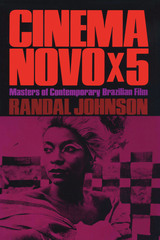 Cinema Novo x 5: Masters of Contemporary Brazilian Film
By Randal Johnson
University of Texas Press, 1984 With such stunning films as Dona Flor and Her Two Husbands, Bye Bye Brazil, and Pixote, Brazilian cinema achieved both critical acclaim and popular recognition in the 1970s and 1980s, becoming the premier cinema of Latin America and one of the largest film producers in the western world. But the success of Brazilian film at home and abroad came after many years of struggle by filmmakers determined to create a strong film industry in Brazil. At the forefront of this struggle were the filmmakers of Cinema Novo, the internationally acclaimed movement whose flowering in the 1960s marked the birth of modern Brazilian film. Cinema Novo x 5 places the success of Brazilian cinema in perspective by examining the films of the five leaders of this groundbreaking movement—Andrade, Diegues, Guerra, Rocha, and dos Santos. By exploring the individuality of these masters of contemporary Brazilian film, Randal Johnson reveals the astonishing stylistic and thematic diversity of Cinema Novo. His emphasis is on the films themselves, as well as their makers’ distinctive cinematic vision and views of what cinema should be and is. At the same time, he provides a wealth of valuable background information to enhance readers’ understanding of the historical, cultural, and economic context in which Cinema Novo was born and flourished.
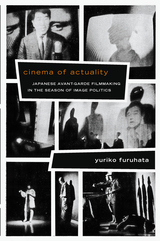 Cinema of Actuality: Japanese Avant-Garde Filmmaking in the Season of Image Politics
Yuriko Furuhata
Duke University Press, 2013 During the 1960s and early 1970s, Japanese avant-garde filmmakers intensely explored the shifting role of the image in political activism and media events. Known as the "season of politics," the era was filled with widely covered dramatic events from hijackings and hostage crises to student protests. This season of politics was, Yuriko Furuhata argues, the season of image politics. Well-known directors, including Oshima Nagisa, Matsumoto Toshio, Wakamatsu Kōji, and Adachi Masao, appropriated the sensationalized media coverage of current events, turning news stories into material for timely critique and intermedial experimentation. Cinema of Actuality analyzes Japanese avant-garde filmmakers' struggle to radicalize cinema in light of the intensifying politics of spectacle and a rapidly changing media environment, one that was increasingly dominated by television. Furuhata demonstrates how avant-garde filmmaking intersected with media history, and how sophisticated debates about film theory emerged out of dialogues with photography, television, and other visual arts.
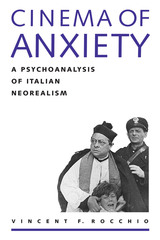 Cinema of Anxiety: A Psychoanalysis of Italian Neorealism
By Vincent F. Rocchio
University of Texas Press, 1999 The "new" realism of Italian cinema after World War II represented and in many ways attempted to contain the turmoil of a society struggling to rid itself of Fascism while fighting off the threat of radical egalitarianism at the same time. In this boldly revisionist book, Vincent F. Rocchio combines Lacanian psychoanalysis with narratology and Marxist critical theory to examine the previously neglected relationship between Neorealist films and the historical spectators they address. Rocchio builds his analysis around case studies of the films Rome: Open City, Bicycle Thieves, La Terra Trema, Bitter Rice, and Senso. Through the lens of psychoanalysis, he challenges the traditional understanding of Neorealism as a progressive cinema and instead reveals the anxieties it encodes: a society in political turmoil, an economic system in collapse, and a national cinema in ruins; while war, occupation, collaboration, and retaliation remain a part of everyday life. These case studies demonstrate how Lacanian psychoanalysis can play a key role in analyzing the structure of cinematic discourse and its strategies of containment. As one of the first books outside of feminist film theory to bring the ideas of Lacan to theories of cinema, this book offers innovative methods that reinvigorate film analysis. Clear and detailed insights into both Italian culture and the films under investigation will make this engaging reading for anyone interested in film and cultural studies.
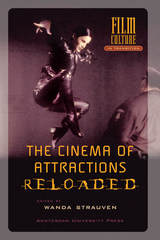 The Cinema of Attractions Reloaded
Edited by Wanda Strauven
Amsterdam University Press, 2007 Twenty years ago, noted film scholars Tom Gunning and André Gaudreault introduced the phrase “cinema of attractions” to describe the essential qualities of films made in the medium’s earliest days, those produced between 1895 and 1906. Now, The Cinema of Attractions Reloaded critically examines the term and its subsequent wide-ranging use in film studies.
The collection opens with a history of the term, tracing the collaboration between Gaudreault and Gunning, the genesis of the term in their attempts to explain the spectacular effects of motion that lay at the heart of early cinema, and the pair’s debts to Sergei Eisenstein and others. This reconstruction is followed by a look at applications of the term to more recent film productions, from the works of the Wachowski brothers to virtual reality and video games.
With essays by an impressive collection of international film scholars—and featuring contributions by Gunning and Gaudreault as well—The Cinema of Attractions Reloaded will be necessary reading for all scholars of early film and its continuing influence.
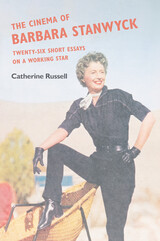 The Cinema of Barbara Stanwyck: Twenty-Six Short Essays on a Working Star
Catherine Russell
University of Illinois Press, 2023 From The Lady Eve, to The Big Valley, Barbara Stanwyck played parts that showcased her multidimensional talents but also illustrated the limits imposed on women in film and television. Catherine Russell’s A to Z consideration of the iconic actress analyzes twenty-six facets of Stanwyck and the America of her times. Russell examines Stanwyck’s work onscreen against the backdrop of costuming and other aspects of filmmaking. But she also views the actress’s off-screen performance within the Hollywood networks that made her an industry favorite and longtime cornerstone of the entertainment community. Russell’s montage approach coalesces into an engrossing portrait of a singular artist whose intelligence and savvy placed her center-stage in the production of her films and in the debates around women, femininity, and motherhood that roiled mid-century America. Original and rich, The Cinema of Barbara Stanwyck is an essential and entertaining reexamination of an enduring Hollywood star.
Cinema of Confinement
Thomas J. Connelly
Northwestern University Press, 2019 In this book, Thomas J. Connelly draws on a number of key psychoanalytic concepts from the works of Jacques Lacan, Slavoj Žižek, Joan Copjec, Michel Chion, and Todd McGowan to identify and describe a genre of cinema characterized by spatial confinement. Examining classic films such as Alfred Hitchcock's Rope and Stanley Kubrick's The Shining, as well as current films such as Room, Green Room, and 10 Cloverfield Lane, Connelly shows that the source of enjoyment of confined spaces lies in the viewer's relationship to excess.
Cinema of Confinement offers rich insights into the appeal of constricted filmic spaces at a time when one can easily traverse spatial boundaries within the virtual reality of cyberspace.
 Cinema of Crushing Motherhood: A New Feminist Cinema
Olivia Landry
University of Illinois Press, 2025 Twenty-first century contemporary films like Emily Atef’s Das Fremde in mir and Savannah Leaf’s Earth Mama portray motherhood as a source of regret, exhaustion, rage, shame, guilt, and disgust. Olivia Landry analyzes this new feminist cinema and the ways it embraces and explores the crushing burden of mothering children. Landry surveys films released in North America, Europe, and Australia over a period beginning in 2007. As she shows, revelation and the expression of negative feelings upend the traditional image of the perfect, self-sacrificial, and happy mother. Landry tracks how radical positions like maternal regret and family abolition have replaced age-old tropes while also going beyond portrayals of maternal ambivalence. Her feminist method casts off psychoanalysis and renounces pathological approaches to motherhood to show how a generation of filmmakers have insisted on the subjective position and experience of the mother rather than that of the child. Bold and groundbreaking, Cinema of Crushing Motherhood looks at taboo-breaking films and illuminates the emotions and affects that make them so powerful.
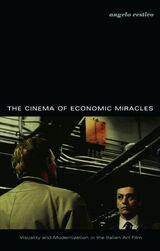 The Cinema of Economic Miracles: Visuality and Modernization in the Italian Art Film
Angelo Restivo
Duke University Press, 2002 The Italian art cinema of the 1960s is known worldwide for its brilliance and vitality. Yet rarely has this cinema been considered in relation to the profound economic and cultural changes that transformed Italy during the sixties--described as the “economic miracle.” Angelo Restivo argues for a completely new understanding of that cinema as a negotiation between a national aesthetic tradition of realism and a nascent postmodern image culture.
Restivo studies numerous films of the period, focusing mainly on the works of Pier Paolo Pasolini and Michelangelo Antonioni. He finds that these auteurs’ films reworked the neorealist aesthetic developed in the 1940s and 1950s, explored issues brought to the fore by the subsequent consumer boom, and presaged developments central to both critical theory and the visual arts in the 1980s and 1990s. Drawing on the theories of Lacan, Zizek, Benjamin, Foucault, Jameson, and Deleuze, he shines new light on such films as Pasolini’s Accattone and Teorema, and Antonioni’s Red Desert and Blow-Up. Restivo’s model for understanding the relationship of the 1960s Italian art film to its cultural contexts also has implications that extend to the developing national cinemas of countries such as Brazil and Taiwan.
The Cinema of Economic Miracles will interest scholars and students in all areas of film studies, especially those studying theories of the image, national cinema theory, and Italian cinema, and to those engaged in poststructuralist theory, philosophy, and comparative literature.
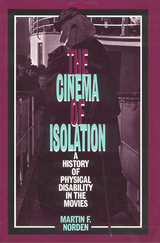 The Cinema of Isolation: A History of Physical Disability in the Movies
Norden, Martin F
Rutgers University Press, 1994 Filmmakers have often encouraged us to regard people with physical disabilities in terms of pity, awe, humor, or fearas "Others" who somehow deserve to be isolated from the rest of society. In this first history of the portrayal of physical disability in the movies, Martin Norden examines hundreds of Hollywood movies (and notable international ones), finds their place within mainstream society, and uncovers the movie industry's practices for maintaining the status quokeeping people with disabilities dependent and "in their place."
Norden offers a dazzling array of physically disabled characters who embody or break out of the stereotypes that have both influenced and been symptomatic of societys fluctuating relationship with its physically disabled minority. He shows us "sweet innocents" like Tiny Tim, "obsessive avengers" like Quasimodo, variations on the disabled veteran, and many others. He observes the arrival of a new set of stereotypes tied to the growth of science and technology in the 1970s and 1980s, and underscores movies like My Left Foot and The Waterdance that display a newfound sensitivity. Nordens in-depth knowledge of disability history makes for a particularly intelligent and sensitive approach to this long-overlooked issue in media studies.
 The Cinema of Mika Kaurismäki: Transvergent Cinescapes, Emergent Identities
Pietari Kääpä
Intellect Books, 2011 Finnish director Mika Kaurismäki’s films challenge the boundaries of nations, genre formations, art and popular culture, and fiction and documentary. Synthesizing concepts from a range of thematic frameworks, including transnationalism, eco-philosophy, architectural theory, and cartography, this book provides an interdisciplinary reading of Kaurismäki’s body of work. The notion of “transvergence”—thinking in heterogeneous and polyphonal terms—emerges as an analytical method for exploring the power of these films. Through this method, the book encourages a rethinking of transnational cinema studies in relation to many oft-debated notions such as Finnish culture, European identity, cosmopolitanism and globalization. A PDF version of this book is available for free in open access via the OAPEN Library platform, www.oapen.org It has been made available under a Creative Commons Attribution 4.0 International Public License and is part of Knowledge Unlatched.
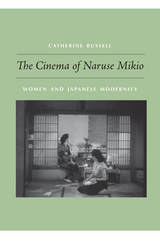 The Cinema of Naruse Mikio: Women and Japanese Modernity
Catherine Russell
Duke University Press, 2008 One of the most prolific and respected directors of Japanese cinema, Naruse Mikio (1905–69) made eighty-nine films between 1930 and 1967. Little, however, has been written about Naruse in English, and much of the writing about him in Japanese has not been translated into English. With The Cinema of Naruse Mikio, Catherine Russell brings deserved critical attention to this under-appreciated director. Besides illuminating Naruse’s contributions to Japanese and world cinema, Russell’s in-depth study of the director sheds new light on the Japanese film industry between the 1930s and the 1960s. Naruse was a studio-based director, a company man renowned for bringing films in on budget and on time. During his long career, he directed movies in different styles of melodrama while displaying a remarkable continuity of tone. His films were based on a variety of Japanese literary sources and original scripts; almost all of them were set in contemporary Japan. Many were “women’s films.” They had female protagonists, and they depicted women’s passions, disappointments, routines, and living conditions. While neither Naruse or his audiences identified themselves as “feminist,” his films repeatedly foreground, if not challenge, the rigid gender norms of Japanese society. Given the complex historical and critical issues surrounding Naruse’s cinema, a comprehensive study of the director demands an innovative and interdisciplinary approach. Russell draws on the critical reception of Naruse in Japan in addition to the cultural theories of Harry Harootunian, Miriam Hansen, and Walter Benjamin. She shows that Naruse’s movies were key texts of Japanese modernity, both in the ways that they portrayed the changing roles of Japanese women in the public sphere and in their depiction of an urban, industrialized, mass-media-saturated society.
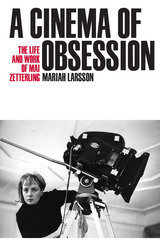 A Cinema of Obsession: The Life and Work of Mai Zetterling
Mariah Larsson
University of Wisconsin Press, 2020 Mai Elizabeth Zetterling (1925–94) is among the most exceptional postwar female filmmakers. Born in Sweden, she lived in England and France for most of her life, making her directorial debut in 1964 with the Swedish art film Loving Couples after a fraught transition from working in front of the camera as a successful actress.
Critics have compared her work to that of Ingmar Bergman, Luis Buñuel, and Federico Fellini, but Zetterling had a distinct style—alternately radical and reactionary—that straddled the gendered divide between high art and mass culture. Tackling themes of sexuality, isolation, and creativity, her documentaries, short and feature films, and television works are visually striking. Her oeuvre provoked controversy and scandal through her sensational representations of reproduction and motherhood.
Mariah Larsson provides a lively and authoritative take on Zetterling's legacy and complicated position within film and women's history. A Cinema of Obsession provides necessary perspective on how the breadth of an artist's collected works keeps gatekeepers from recognizing their achievements, and questions why we still distinguish between national and global visual cultures and the big and small screens in the #MeToo era.
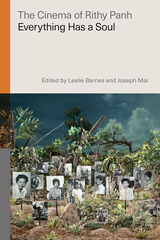 The Cinema of Rithy Panh: Everything Has a Soul
Leslie Barnes
Rutgers University Press, 2022 Nominated for 2022 South Atlantic Modern Language Association Book award
Born in 1964, Cambodian filmmaker Rithy Panh grew up in the midst of the Khmer Rouge’s genocidal reign of terror, which claimed the lives of many of his relatives. After escaping to France, where he attended film school, he returned to his homeland in the late 1980s and began work on the documentaries and fiction films that have made him Cambodia’s most celebrated living director.
The fourteen essays in The Cinema of Rithy Panh explore the filmmaker’s unique aesthetic sensibility, examining the dynamic and sensuous images through which he suggests that “everything has a soul.” They consider how Panh represents Cambodia’s traumatic past, combining forms of individual and collective remembrance, and the implications of this past for Cambodia’s transition into a global present. Covering documentary and feature films, including his literary adaptations of Marguerite Duras and Kenzaburō Ōe, they examine how Panh’s attention to local context leads to a deep understanding of such major themes in global cinema as justice, imperialism, diaspora, gender, and labor.
Offering fresh takes on masterworks like The Missing Picture and S-21 while also shining a light on the director’s lesser-known films, The Cinema of Rithy Panh will give readers a new appreciation for the boundless creativity and ethical sensitivity of one of Southeast Asia’s cinematic visionaries.
 The Cinema of Robert Rodriguez
By Frederick Luis Aldama
University of Texas Press, 2014 Robert Rodriguez stands alone as the most successful U.S. Latino filmmaker today, whose work has single-handedly brought U.S. Latino filmmaking into the mainstream of twenty-first-century global cinema. Rodriguez is a prolific (eighteen films in twenty-one years) and all-encompassing filmmaker who has scripted, directed, shot, edited, and scored nearly all his films since his first breakout success, El Mariachi, in 1992. With new films constantly coming out and the launch of his El Rey Network television channel, he receives unceasing coverage in the entertainment media, but systematic scholarly study of Rodriguez’s films is only just beginning. The Cinema of Robert Rodriguez offers the first extended investigation of this important filmmaker’s art. Accessibly written for fans as well as scholars, it addresses all of Rodriguez’s feature films through Spy Kids 4 and Machete Kills, and his filmmaking process from initial inspiration, to script, to film (with its myriad visual and auditory elements and choices), to final product, to (usually) critical and commercial success. In addition to his close analysis of Rodriguez’s work, Frederick Luis Aldama presents an original interview with the filmmaker, in which they discuss his career and his relationship to the film industry. This entertaining and much-needed scholarly overview of Rodriguez’s work shines new light on several key topics, including the filmmaker’s creative, low-cost, efficient approach to filmmaking; the acceptance of Latino films and filmmakers in mainstream cinema; and the consumption and reception of film in the twenty-first century.
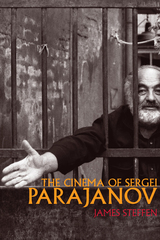 The Cinema of Sergei Parajanov
James Steffen
University of Wisconsin Press, 2013 Sergei Parajanov (1924–90) flouted the rules of both filmmaking and society in the Soviet Union and paid a heavy personal price. An ethnic Armenian in the multicultural atmosphere of Tbilisi, Georgia, he was one of the most innovative directors of postwar Soviet cinema. Parajanov succeeded in creating a small but marvelous body of work whose style embraces such diverse influences as folk art, medieval miniature painting, early cinema, Russian and European art films, surrealism, and Armenian, Georgian, and Ukrainian cultural motifs.
The Cinema of Sergei Parajanov is the first English-language book on the director's films and the most comprehensive study of his work. James Steffen provides a detailed overview of Parajanov's artistic career: his identity as an Armenian in Georgia and its impact on his aesthetics; his early films in Ukraine; his international breakthrough in 1964 with Shadows of Forgotten Ancestors; his challenging 1969 masterpiece, The Color of Pomegranates, which was reedited against his wishes; his unrealized projects in the 1970s; and his eventual return to international prominence in the mid-to-late 1980s with The Legend of the Surami Fortress and Ashik-Kerib. Steffen also provides a rare, behind-the-scenes view of the Soviet film censorship process and tells the dramatic story of Parajanov's conflicts with the authorities, culminating in his 1973–77 arrest and imprisonment on charges related to homosexuality.
Ultimately, the figure of Parajanov offers a fascinating case study in the complicated dynamics of power, nationality, politics, ethnicity, sexuality, and culture in the republics of the former Soviet Union.
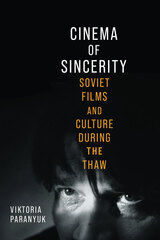 Cinema of Sincerity: Soviet Films and Culture During the Thaw
Viktoria Paranyuk
University of Wisconsin Press, 2025 Following Stalin’s death in 1953 and Khrushchev’s acknowledgment of Stalin’s crimes in 1956, “sincerity” emerged as a cultural imperative in the Soviet Union. The cinema of this period turned inward, insisting on ordinary characters and creating a sense of spontaneity through particular staging methods and cinematic techniques, such as interior monologue and the close-up. These changes shifted the understanding of what “realism” meant and allowed Soviet cinema to reestablish with its audiences the trust that had been corrupted by serving Stalin’s cult of personality.
Using both theory and close readings of specific films produced in the Soviet Union during the Thaw, a period known for its relative political and cultural liberalization, Cinema of Sincerity treats sincerity as both a concept and an aesthetic strategy. Viktoria Paranyuk argues that Soviet cinema’s use of sincerity was a reworking of a trend in global cinema that sought to bridge the gap between reality and the filmed image. This period saw increased accessibility to world cinematic traditions, new voices in criticism, and, above all, the multigenerational effort in filmmaking that developed and thrived in centers outside Moscow. Paranyuk demonstrates how these changes allowed Soviet cinema to renew its visual language and use film as a space for collective self-examination.
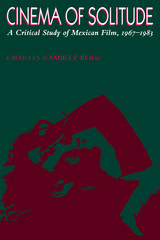 Cinema of Solitude: A Critical Study of Mexican Film, 1967-1983
By Charles Ramírez Berg
University of Texas Press, 1992 La crisis, a period of political and economic turmoil in Mexico that began in the late 1960s, spawned a new era in Mexican cinema. Known as el Nuevo Cine (the New Cinema), these films presented alienated characters caught in a painful transition period in which old family, gender, and social roles have ceased to function without being replaced by viable new ones. These are the films explored by Charles Ramírez Berg in Cinema of Solitude, the first book-length critical study of Mexican cinema in English. Berg discusses the major films and filmmakers of el Nuevo Cine in depth. He analyzes dozens of commercial movies, from popular comedies and adventures to award-winning films. Introductory chapters address the issue of mexicanidad (Mexican national identity) and outline Mexican history, the history of film as popular culture and as a leading national industry, and the ideological dynamics of Mexican cinema. In thematically arranged chapters, Berg investigates the images of women, men, and social structures portrayed in New Cinema films. He finds that women characters have begun to reject traditional stereotypes for more positive images, while male characters have grown ambiguous and undefined as machismo is abandoned. Other chapters trace the continuing marginalization of Indians in Mexican culture, the changes in male dominance within the family, and the disruptive social and economic effects caused by migration. For everyone interested in Mexican culture as reflected in its major cinematic productions, as well as students of film theory and national cinemas, this book will be important reading.
 The Cinema of Urban Crisis: Seventies Film and the Reinvention of the City
Lawrence Webb
Amsterdam University Press, 2015 In the 1970s, cities across the United States and Western Europe faced a deep social and political crisis that challenged established principles of planning, economics and urban theory. At the same time, film industries experienced a parallel process of transition, the effects of which rippled through the aesthetic and narrative form of the decade's cinema. The Cinema of Urban Crisis traces a new path through the cinematic legacy of the 1970s by drawing together these intertwined histories of urban and cultural change. Bringing issues of space and place to the fore, the book unpacks the geographical and spatial dynamics of film movements from the New Hollywood to the New German Cinema, showing how the crisis of the seventies and the emerging 'postindustrial' economy brought film and the city together in new configurations.
Chapters cover a range of cities on both sides of the Atlantic, from New York, Philadelphia and San Francisco to London, Paris and Berlin. Integrating analysis of film industries and production practices with detailed considerations of individual texts, the book offers strikingly original close analyses of a wide range of films, from New Hollywood (The Conversation, The King of Marvin Gardens, Rocky) to European art cinema (Alice in the Cities, The Passenger, Tout va Bien) and popular international genres such as the political thriller and the crime film. Focusing on the aesthetic and representational strategies of these films, the book argues that the decade's cinema engaged with - and helped to shape - the passage from the 'urban crisis' of the late sixties to the neoliberal 'urban renaissance' of the early eighties. Splicing ideas from film studies with urban geography and architectural history, the book offers a fresh perspective on a rich period of film history and opens up new directions for critical engagement between film and urban studies.
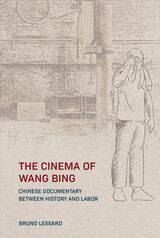 The Cinema of Wang Bing: Chinese Documentary between History and Labor
Bruno Lessard
Hong Kong University Press, 2023 An examination of the films of Chinese documentarian Wang Bing.
In The Cinema of Wang Bing, Bruno Lessard examines documentarian Wang Bing’s most important films. He focuses on the two obsessions at the heart of Wang’s oeuvre—the legacy of Maoist China in the present and the transformation of labor since China’s entry into the market economy—and how the crucial figures of survivor and worker are represented on screen. Bruno Lessard argues that Wang is a minjian (grassroots) intellectual whose films document the impact of Mao’s Great Leap Forward on Chinese collective memory and register the repercussions of China’s turn to neoliberalism on workers in the post-Reform era. Bringing together Chinese documentary studies and China studies, Lessard shows how Wang’s practice reflects the minjian ethos when documenting the survivors of the Great Famine and those who have not benefitted from China’s neoliberal policies—from laid-off workers to migrant workers. The films discussed include some of Wang’s most celebrated works such as West of the Tracks and Dead Souls, as well as neglected documentaries such as Coal Money and Bitter Money.
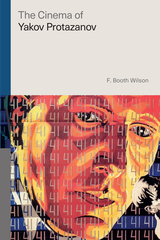 The Cinema of Yakov Protazanov
F. Booth Wilson
Rutgers University Press, 2024 Best known for Aelita (1924), the classic science-fiction film of the Soviet silent era, Yakov Protazanov directed over a hundred films in a career spanning three decades. Called "the Russian D.W. Griffith" in the 1910s for his formative role in the first movies in the last years of the Russian Empire, he fled the Civil War and maintained a successful career in Europe before making an unusual decision to return to Russia now under Soviet power. There his films continued their remarkable success with audiences undergoing a bewildering and often brutal revolutionary transformation. Rather than treating him as an indistinct, if capable craftsman, The Cinema of Yakov Protazanov argues that his films are suffused with a unique creative vision that reflects both his mindset as a traditional Russian intellectual and his experience of dislocation and migration after 1917. As he adapted his films to revolutionary culture, they intermingled different voices and reinterpreted his past work from a disavowed era. Offering fresh perspectives of Protazanov’s films, the book will give readers a new appreciation of his career. The book offers a uniquely valuable vantage point from which to explore how cinema reflected a society in transformation and a seminal moment in the development of cinematic art.
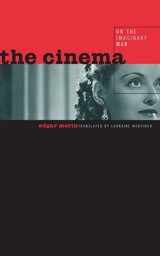 The Cinema, or The Imaginary Man
Edgar Morin
University of Minnesota Press, 2005 When The Cinema, or The Imaginary Man first appeared in 1956, the movies and the moviegoing experience were generally not regarded as worthy of serious scholarly consideration. Yet, French critic and social theorist Edgar Morin perceived in the cinema a complex phenomenon capable of illuminating fundamental truths about thought, imagination, and human nature - which allowed him to connect the mythic universe of gods and spirits present within the most primitive societies to the hyperreality emanating from the images projected on the screen. Now making its English-language debut, this audacious, provocative work draws on insights from poets, filmmakers, anthropologists, and philosophers to restore to the cinema the sense of magic first enjoyed at the dawn of the medium. Morin's inquiry follows two veins of investigation. The first focuses on the cinematic image as the nexus between the real and the imaginary; the second examines the cinema's re-creation of the archaic universe of doubles and ghosts and its power to possess, to bewitch, to nourish dreams, desires, and aspirations. "We experience the cinema in a state of double consciousness," Morin writes, "an astonishing phenomenon where the illusion of reality is inseparable from the awareness that it is really an illusion."
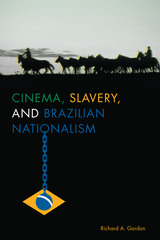 Cinema, Slavery, and Brazilian Nationalism
By Richard A. Gordon
University of Texas Press, 2015 A unique contribution to film studies, Richard Gordon’s Cinema, Slavery, and Brazilian Nationalism is the first full-length book on Brazilian films about slavery. By studying Brazilian films released between 1976 and 2005, Gordon examines how the films both define the national community and influence viewer understandings of Brazilianness. Though the films he examines span decades, they all communicate their revised version of Brazilian national identity through a cinematic strategy with a dual aim: to upset ingrained ways of thinking about Brazil and to persuade those who watch the films to accept a new way of understanding their national community. By examining patterns in this heterogeneous group of films, Gordon proposes a new way of delineating how these films attempt to communicate with and change the minds of audience members. Gordon outlines five key aspects that each film incorporates, which describe their shared formula for and role in constructing social identity. These elements include the ways in which the films attempt to create links between the past and the viewers’ present and their methods of encouraging viewers to identify with their protagonists, who are often cast as a prototype for the nation. By aligning themselves with this figure, viewers arrive at a definition of their national identity that, while Afrocentric, also promotes racial and ethnic inclusiveness. Gordon’s innovative analysis transcends the context of his work, and his conclusions can be applied to questions of national identity and film across cultures.
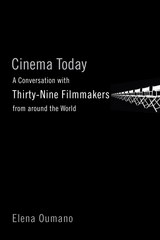 Cinema Today: A Conversation with Thirty-nine Filmmakers from around the World
Oumano, Elena
Rutgers University Press, 2011 Imagine attending a fascinating film forum among a distinguished and varied panel of cinema legends. An afternoon or evening where contemporary filmmakers from around the world--Kazakhstan, Turkey, Macedonia, Portugal, Chile, Argentina, Egypt, Cameroon, Australia, the Philippines, South Africa, Greece, Portugal, Sweden, Japan, the People's Republic of China, Mexico, Poland, the United States, Italy, the United Kingdom, and France--gather together to discuss how they arrive at the creative choices that bring their film projects to life.
Can't spare the time from work or class? Travel expense too great? What? You can't even find such a collaborative event?
Then imagine curling up with a good book, maybe a shot of espresso in hand, and becoming engrossed in the exciting and informative conversation that Elena Oumano has ingeniously crafted from her personal and individual interviews with these artists. Straying far from the usual choppy question-and-answer format, Cinema Today saves you from plowing through another tedious read, in which the same topics and issues are directed to each subject, over and over-an experience that is like being trapped in a revolving door.
Oumano stops that revolving door by following a lively symposium-in-print format, with the filmmakers' words and thoughts grouped together under various key cinema topics. It is as though these experts are speaking to each other and you are their audience--collectively they reflect on and explore issues and concerns of modern filmmaking, from the practical to the aesthetic, including the process, cinematic rhythm and structure, and the many aspects of the media: business, the viewer, and cinema's place in society. Whether you are a movie lover, a serious student of cinema, or simply interested in how we communicate in today's global village through films that so profoundly affect the world, Cinema Today is for you.
 Cinema under National Reconstruction: State Censorship and South Korea’s Cold War Film Culture
Hye Seung Chung
Rutgers University Press, 2025 Cinema under National Reconstruction calls for a revisionist understanding of state film censorship during successive Cold War military regimes in South Korea (1961–1988). Drawing upon primary documents from the Korean Film Archive’s digitized database and framing South Korean film censorship from a transnational perspective, Hye Seung Chung makes the case that, while political oppression/repression existed inside and outside the film industry during this period, film censorship was not simply a tool for authoritarian dictatorship. Through such case studies as Yu Hyun-mok’s The Stray Bullet (1961), Ha Kil-jong’s The March of the Fools (1975), and Yi Chang-ho’s Declaration of Fools (1983), the author defines censorship as a dialogical process of cultural negotiations wherein the state, the film industry, and the public fight out a battle over the definitions and functions of national cinema. In the context of Cold War Korea, one cannot fully understand or construct film history without reassessing censorship as a productive feedback system where both state regulators and filmmakers played active roles in shaping the new narrative or sentiment of the nation on the big screen.
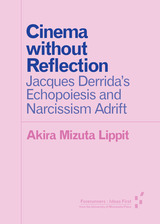 Cinema without Reflection: Jacques Derrida’s Echopoiesis and Narcissim Adrift
Akira Mizuta Lippit
University of Minnesota Press, 2016 Cinema without Reflection traces an implicit film theory in Jacques Derrida’s oeuvre, especially in his frequent invocation of the myth of Echo and Narcissus. Derrida’s reflections on the economies of image and sound that reverberate in this story, along with the spectral dialectics of love, mirrors, and poiesis, serve as the basis for a theory of cinema that Derrida perhaps secretly imagined.
Following Derrida’s interventions on Echo and Narcissus across his thought on the visual arts, Akira Mizuta Lippit seeks to return to a theory of cinema adrift in Derrida’s philosophy.
Forerunners is a thought-in-process series of breakthrough digital works. Written between fresh ideas and finished books, Forerunners draws on scholarly work initiated in notable blogs, social media, conference plenaries, journal articles, and the synergy of academic exchange. This is gray literature publishing: where intense thinking, change, and speculation take place in scholarship.
|
|
